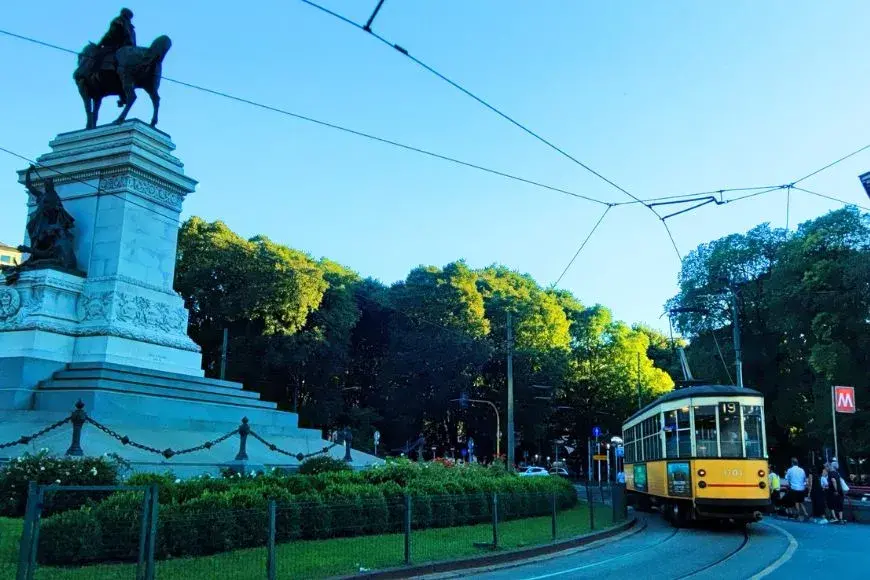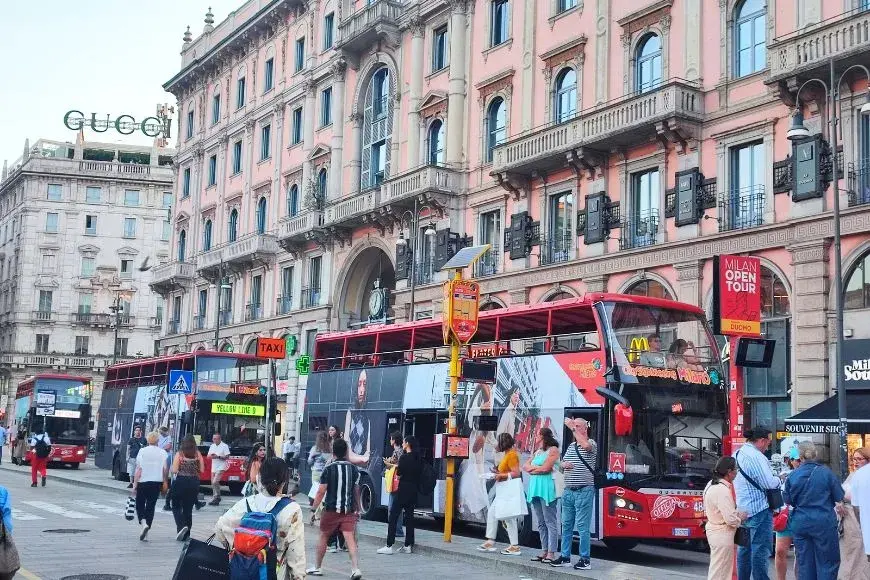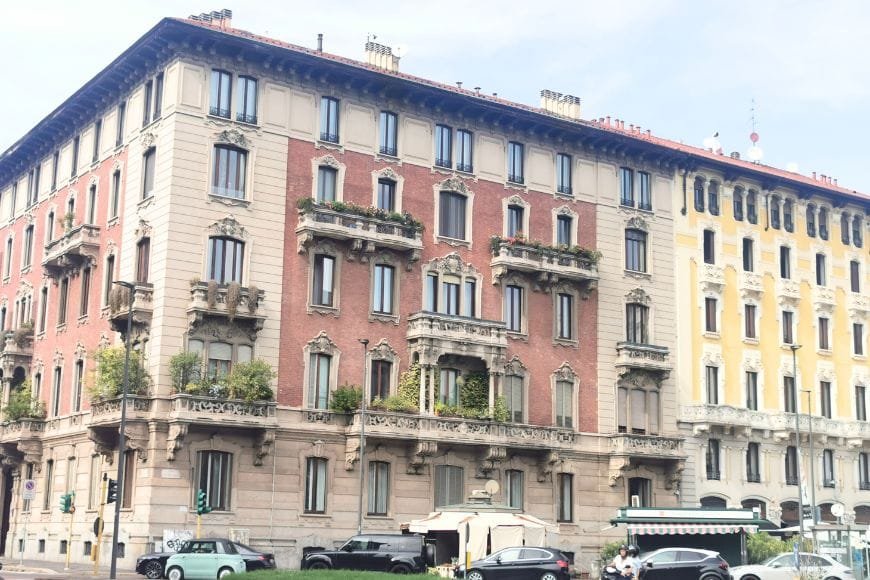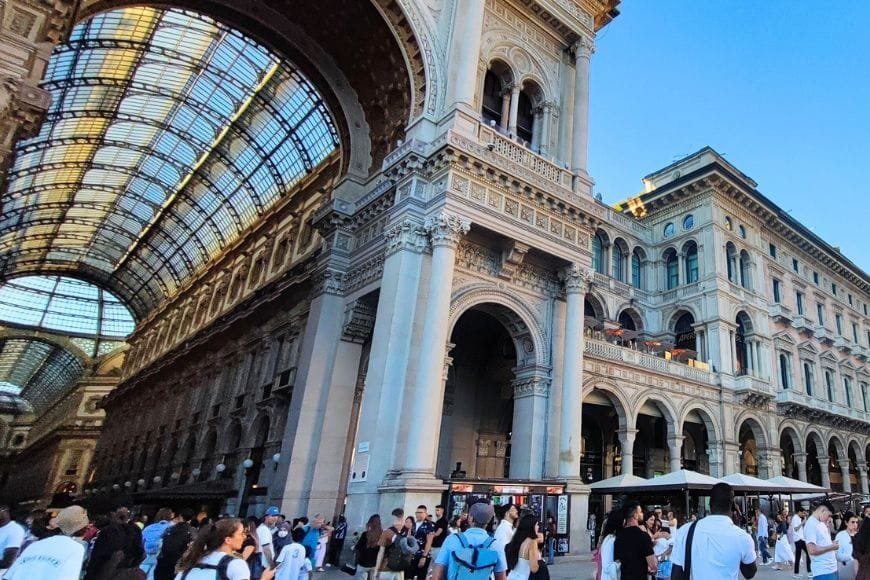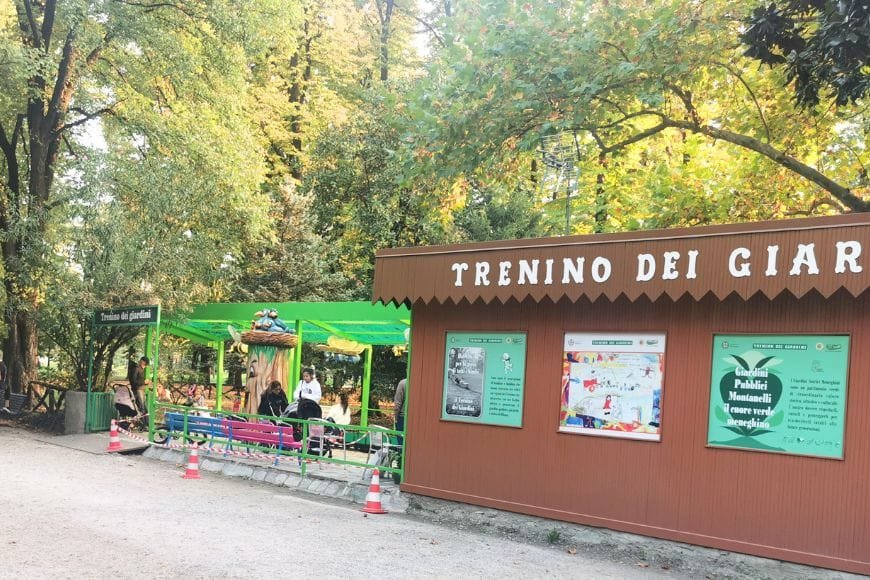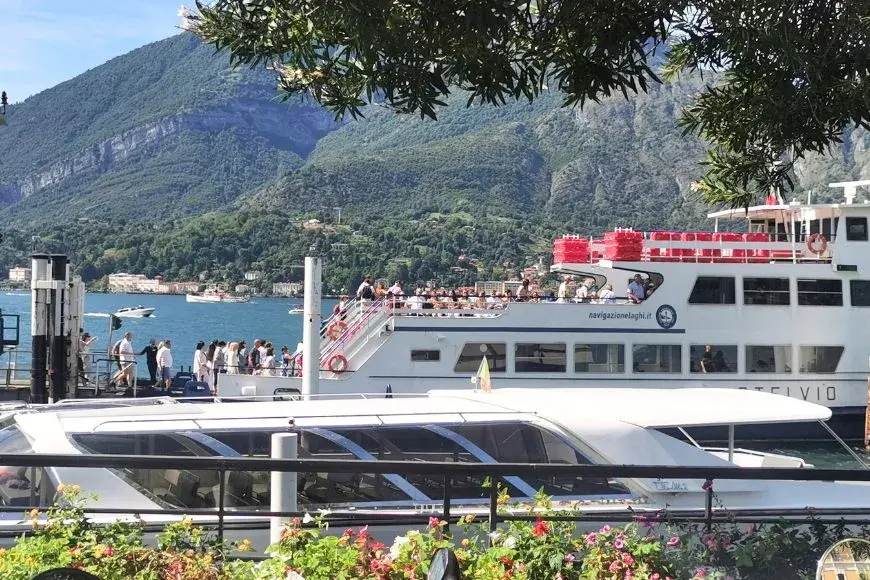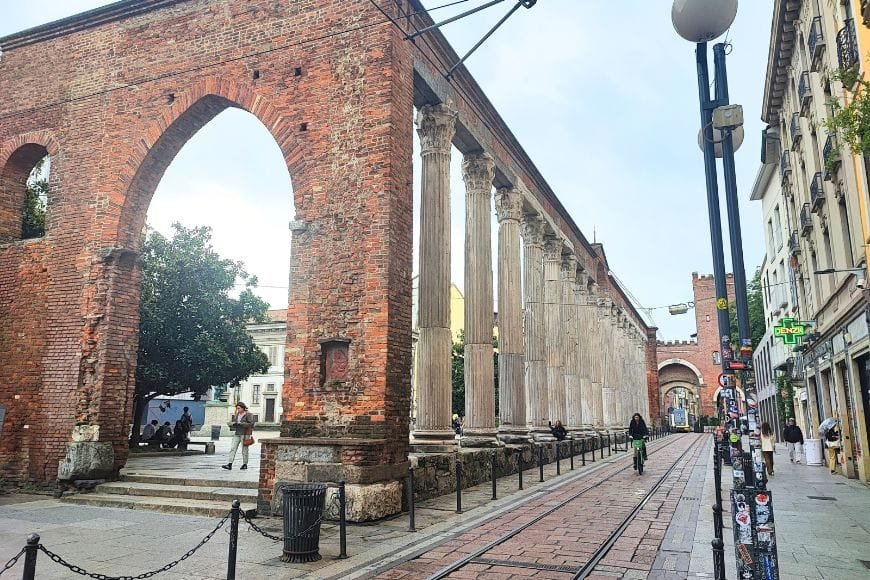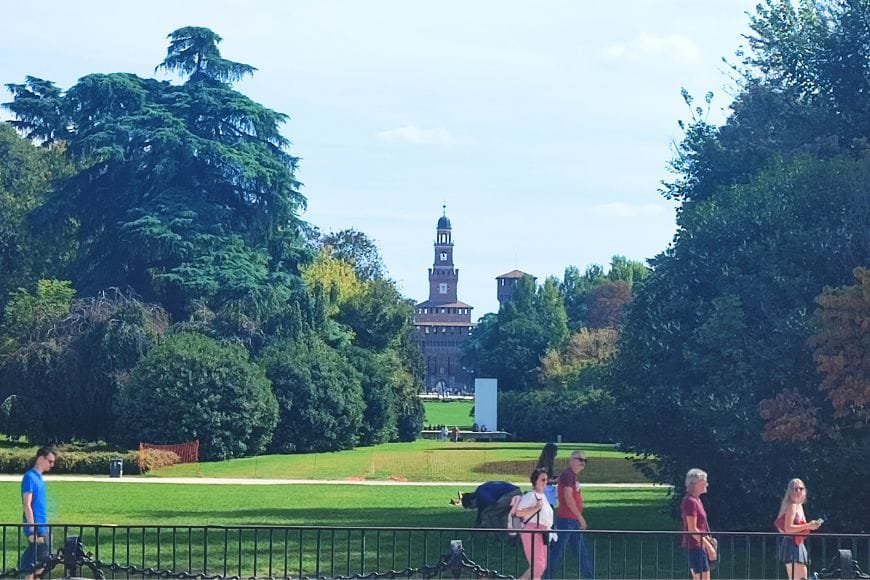The Ultimate Italy Travel Guide (2025): Insider Tips, Itineraries & Local Secrets for First Timers

by Luca | Last Updated December 20, 2025
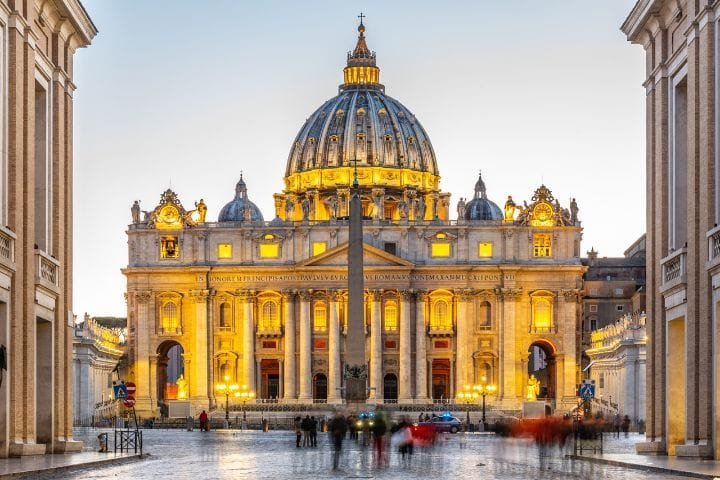
As someone who has called Italy home for over three decades – growing up in Florence, spending university years in Bologna, and now living between Rome and my family’s vineyard in Tuscany – I can tell you that our country isn’t just one of the world’s most visited destinations by accident. Honestly? It’s basically impossible to have a bad time here, even when things don’t go according to plan.
Whether you’re dreaming of tossing coins in Roman fountains (yeah, touristy but magical), getting authentically lost in Venetian back canals, or savoring wine at sunset from the same hilltop where my nonna taught me to appreciate la dolce vita, Italy delivers those postcard-perfect moments that make your friends back home seriously jealous.
Sure, it can get crowded and touristy in spots – let’s not sugarcoat it – but here’s the thing: with insider knowledge from someone who’s actually lived here through every season, you’ll discover the Italy that even many repeat visitors miss.
This comprehensive Italy travel guide covers everything you need to plan an unforgettable Italian adventure, from must-visit destinations and realistic itineraries to practical logistics and local secrets that only someone who grew up here can share. Trust me on this one – by the end of this guide, you’ll have everything needed to experience Italy like someone who belongs here, not just visits.
How to Plan a Trip to Italy?
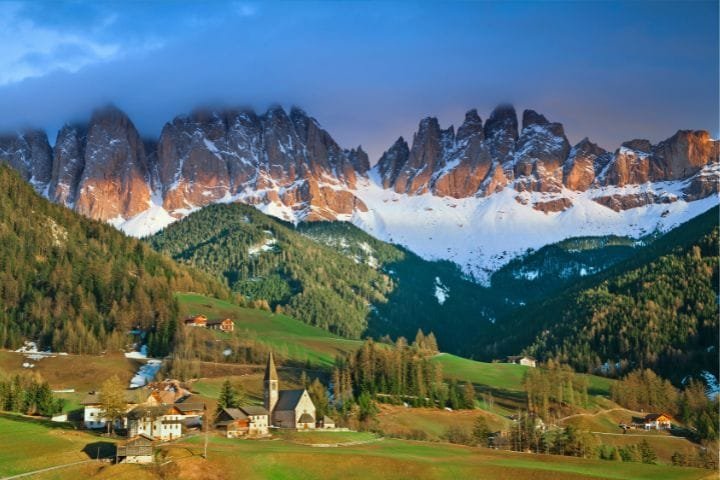
Having helped countless American friends, cousins, and colleagues plan their Italian adventures over the years, I’ve learned that good planning doesn’t have to be overwhelming – it’s all about tackling things in the right order and knowing which details actually matter.
Planning Timeline: 6 months/ 3 months/ 1 month
6 Months Before: Dream and Book Big Picture
Start with the fun part – figuring out what kind of Italian experience speaks to your soul. Growing up here, I’ve learned each region has its own personality:
- History and art lovers: Rome and Florence are obvious, but don’t overlook Naples for incredible museums or Ravenna for stunning Byzantine mosaics
- Romantic souls: Italian lakes, Chianti wine country, or Amalfi Coast deliver those dreamy moments
- Food obsessives: Emilia-Romagna (Bologna, Parma, Modena) is where we Italians go when we want to eat seriously well
- Adventure seekers: Dolomites offer world-class hiking and skiing that rivals anywhere in Europe
Book flights early, especially for peak season. Main entry points worth considering:
- Rome Fiumicino: Best for exploring central and southern Italy
- Milan Malpensa: Perfect gateway for northern regions and lakes
- Venice Marco Polo: Ideal for northeastern Italy and connections to Slovenia/Austria
Flying into one city and departing from another often saves money and creates better itinerary flow – like Rome arrival, Milan departure for that perfect north-south adventure.
3 Months Before: Documents and Logistics
Let me walk you through the paperwork as someone who’s guided plenty of friends through Italian entry requirements:
Essential documents:
- Valid passport: Must remain valid for at least 3 months beyond your departure date
- ETIAS authorization: Starting 2025, Europe’s new system (easy online application, takes minutes)
- Travel insurance: Not legally required, but absolutely essential
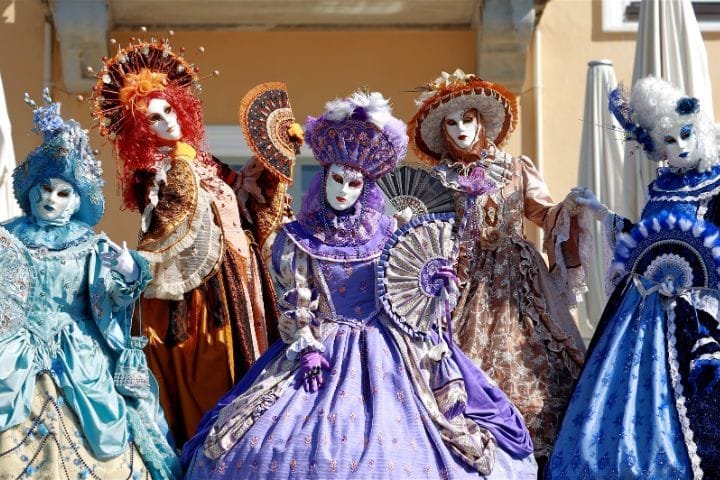
Here’s the thing – I learned this lesson the hard way when my friend from Chicago broke her ankle hiking in the Dolomites. Good travel insurance saved her thousands in medical costs and got her home safely. Get coverage including:
- Medical expenses and emergency evacuation
- Trip interruption and cancellation protection
- Lost luggage coverage
1 Month Before: Apps and Reservations
Time to download the digital tools that’ll make your Italian adventure flow smoothly. As someone who uses these daily, here’s what actually works:
Must-have apps:
- Trenitalia: Essential for train travel (and you’ll definitely be taking trains)
- Google Maps: Works perfectly throughout Italy, even in tiny hill towns
- Google Translate: The Camera feature is amazing for reading menus
- TheFork: Restaurant reservations – we locals use this constantly
Book your must-do experiences now. Popular attractions that sell out include:
- Vatican Museums and Sistine Chapel
- Uffizi Gallery in Florence
- Last Supper viewing in Milan
- Cooking classes in Bologna (totally worth it)
Last summer, I watched disappointed tourists get turned away from the Vatican because everything was fully booked – don’t let that be you. The earlier you book these, the better your time slots and the lower your stress levels will be.
What is the Best Time of Year to Visit Italy?
After living through decades of Italian seasons and watching how they affect both locals and visitors, here’s the real scoop – it totally depends on what you’re after and how you handle crowds, heat, and the occasional rainy day.
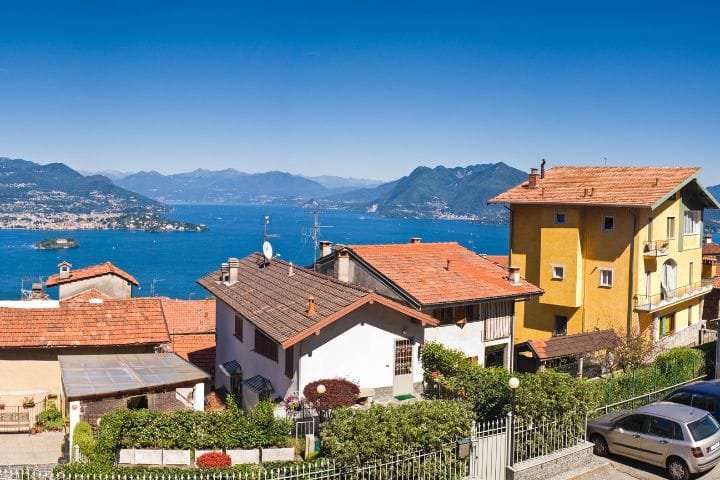
Visit Italy in Spring (March-May): The Sweet Spot
Honestly? Spring might be the absolute best time to experience Italy, and I say this as someone who has lived through every season here multiple times. Growing up in Florence, I learned that spring weather is pure magic – warm but not sweltering, perfect for all that walking you’ll be doing through our historic centers.
Why spring rocks:
- Wildflowers blooming across Tuscany and Umbria (absolutely breathtaking)
- Tourist crowds are totally manageable
- Accommodation prices haven’t hit summer peaks yet
- Perfect weather for outdoor dining and long evening walks
- Easter celebrations in Rome are genuinely moving experiences
Spring reality check:
- Weather can be unpredictable – pack layers
- Mountain areas like the Dolomites might still have snow at higher elevations
- Some coastal businesses haven’t fully opened yet
Last April, I took my visiting cousins from Chicago through the Chianti region during wildflower season. The rolling hills covered in poppies and bright yellow rapeseed made them understand why people fall head-over-heels for our countryside. We had perfect 20°C days, hardly any crowds, and restaurant terraces were just opening for the season.
Italy in Summer (June-August): Peak Everything
Let’s not sugarcoat it – summer in Italy can be seriously intense. I remember working in Rome one July and watching tourists literally struggling with the heat while locals took their traditional afternoon break. We’re talking temperatures that can hit 38°C+ in Rome and southern regions, plus crowds that make famous attractions feel like sardine cans.
Summer reality:
- Intense heat, especially in central and southern Italy
- Massive tourist crowds at popular destinations
- Higher accommodation prices across the board
- Long lines at major attractions
But summer magic includes:
- Long days perfect for late evening dining (sunset at 8:30 PM!)
- Outdoor festivals and events happening everywhere
- Peak energy in coastal towns and beach culture
- Traditional Italian summer lifestyle in full swing
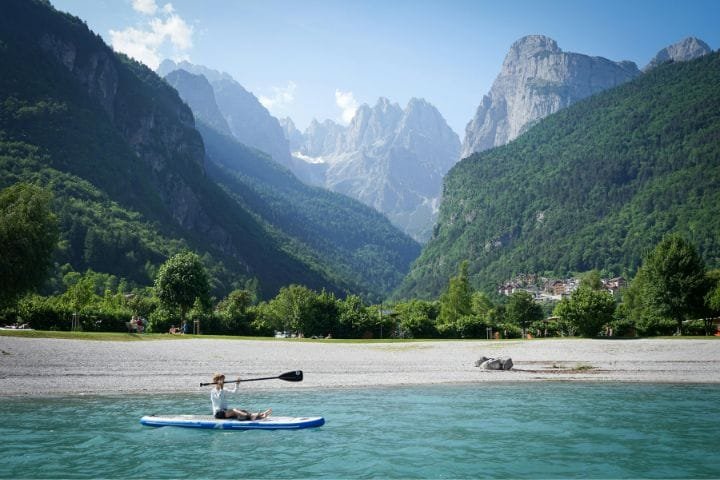
Here’s my advice if you’re set on summer travel: embrace the Italian approach. Start sightseeing early morning, take a proper siesta during peak heat (2-5 PM like we do), and save outdoor activities for evening when temperatures drop and that magical golden hour light makes everything Instagram-worthy.
Get our FREE Italy
Travel Guide
E-Book
This printable guide is your ultimate companion for exploring Italy, with insider tips, detailed itineraries, transportation advice, must-see attractions, and more.
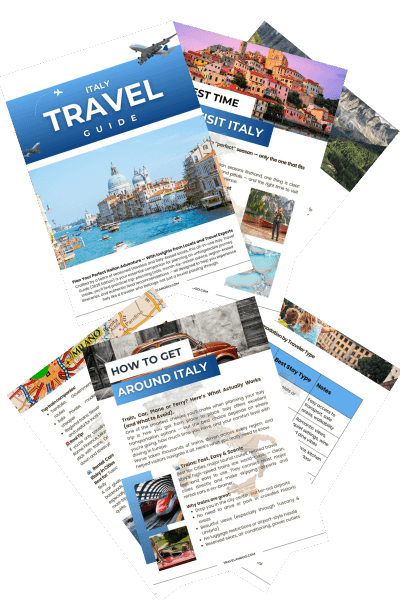
Fall (September-November): Wine Season Gold
Fall is absolutely brilliant for Italy travel, especially if you’re into food and wine. September still has that warm summer energy, but with way fewer crowds, while October and November bring perfect walking weather. As someone who helps with harvest at our family vineyard in Chianti, I can tell you autumn is when our countryside truly shines.
Fall highlights:
- Harvest season in wine regions (incredible hands-on experiences available)
- Perfect walking temperatures for city exploration
- Gorgeous autumn colors in northern regions
- Local festivals celebrating seasonal foods like truffles and chestnuts
Fall considerations:
- Some coastal businesses start reducing hours by late October
- Weather becomes more unpredictable in November
- Mountain passes may close for winter season
Two years ago, I brought friends from New York to Piedmont during white truffle season. Watching them discover fresh Alba truffles for the first time while surrounded by golden vineyard landscapes and crisp autumn air was pure magic – they still talk about that trip.
Winter (December-February): Authentic and Underrated
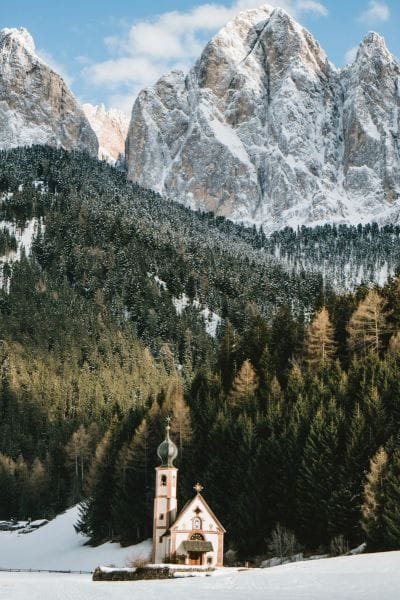
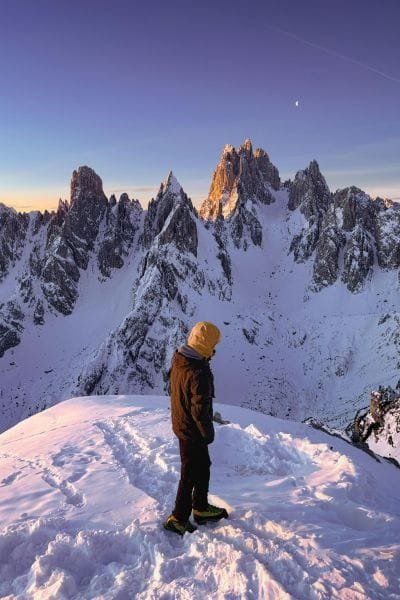
Winter Italy is totally underrated, and I say this as someone who’s experienced our country in all seasons. Yeah, it’s cold and many coastal attractions have limited hours, but you’ll experience Italy at its most authentic – the way we actually live when tourists aren’t around.
Winter advantages:
- Authentic local experiences without tourist crowds
- Significantly lower accommodation prices
- Christmas markets in northern cities (especially Alto Adige region)
- Excellent skiing in Dolomites and Alps
- Cozy trattorias with hearty winter dishes
Winter realities:
- Cold temperatures, especially in northern regions
- Limited hours for coastal attractions
- Some mountain roads may be closed
- Shorter daylight hours for sightseeing
Growing up, our family’s Christmas celebrations in small Tuscan villages showed me how magical Italy becomes during the winter holidays. The warmth of local traditions, incredible seasonal foods, and genuine hospitality more than make up for the cold weather.
Regional Timing Breakdown
Here’s where my local knowledge really helps – Italy’s incredibly diverse, so timing varies dramatically by region:
| Region | Best Time to Visit | Seasonal Notes |
|---|---|---|
| Amalfi Coast & Southern Italy | April–June, September–October | ☀️ Summer can be brutally hot and overcrowded; ❄️ Winter sees many hotels and restaurants closed |
| Dolomites & Northern Mountains | Hiking: June–September Skiing: December–March | 🍂 Shoulder seasons can have unpredictable weather |
| Tuscany & Central Italy | April–June, September–November | 🌞 Summer is manageable with proper siesta strategy; ❄️ Winter offers authentic local experiences |
| Sicily & Deep South | Year-round | 🔥 Summer can be very hot, but coastal breezes help; ❄️ Winter is pleasant for sightseeing while northern Europe is freezing |
Italy Itinerary Ideas (7 to 21 Days)
As someone who’s planned countless trips for visiting friends, family, and colleagues over the years, there’s honestly no single “best” itinerary – it all depends on your interests, travel style, and whether you want to pack everything in or really savor each destination.
Italy Itinerary 7 Days: The Classic Triangle
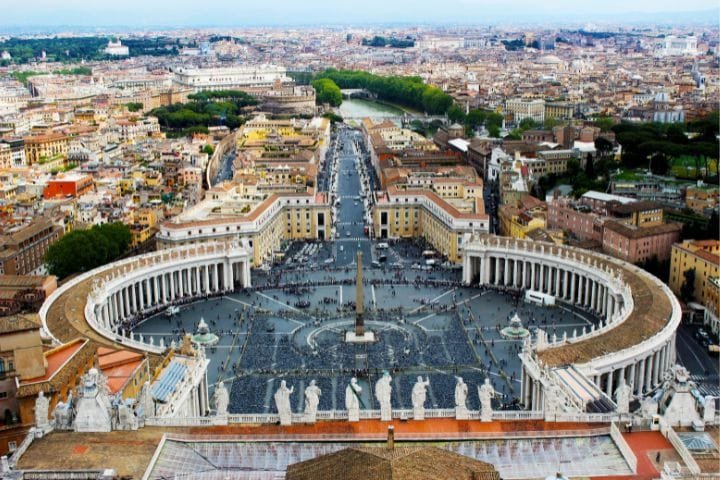
This is the tried-and-true first-timer route that I recommend to most visitors: Rome (3 days), Florence (2 days), Venice (2 days). Yeah, it’s what everyone does, but here’s the thing – there’s a reason this combination works so perfectly. These three cities give you an incredible overview of Italian history, art, and culture, plus the high-speed trains make connections totally effortless.
Days 1-3: Rome (The Eternal Foundation)
- Major sites: Colosseum, Vatican Museums, Roman Forum (book skip-the-line tickets!)
- Neighborhood wandering: Trastevere for dinner, Monti for aperitivo where locals actually hang out
- Evening strolls: Pantheon to Trevi Fountain to Spanish Steps route
- Day trip option: Ostia Antica ruins or Tivoli gardens if you need a break from city intensity
Days 4-5: Florence (Renaissance Perfection)
- Art immersion: Uffizi Gallery, Duomo dome climb for those incredible city views
- Ponte Vecchio crossing and Oltrarno exploration for authentic artisan workshops
- Day trip possibilities: Siena medieval charm, San Gimignano towers, or Pisa if you must
- Evening scene: Aperitivo in Santo Spirito square, where Florentines actually gather
Days 6-7: Venice (Floating Dreams)
- Canal wandering: Seriously, put away the map sometimes and just get lost
- Major sights: St. Mark’s Square and Basilica, Doge’s Palace for Venetian history
- Gondola experience: Yeah, it’s touristy and expensive, but sunset rides are genuinely magical
- Island hopping: Murano for glass-making demonstrations, Burano for those colorful houses
When my friend from Toronto did this exact route last spring, they were amazed how different each city felt despite being in the same country. Rome’s ancient energy, Florence’s artistic soul, Venice’s impossible beauty – it’s like experiencing three different civilizations.
Italy Itinerary 10 Days: Milan to Amalfi Road Trip
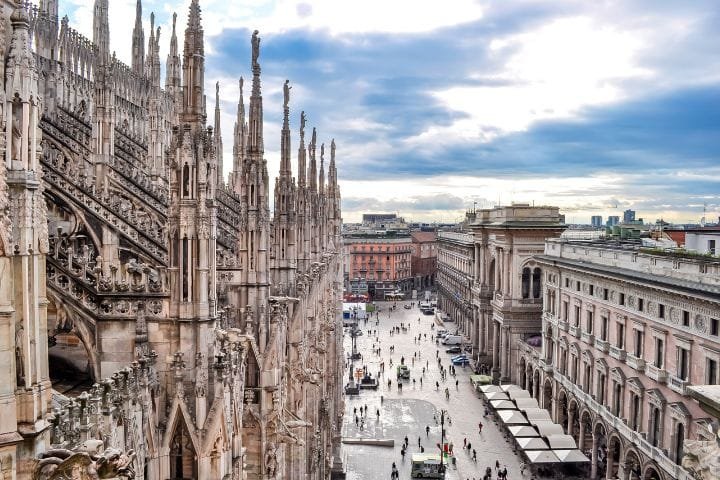
This Italy 10-day itinerary adventure showcases the country’s incredible geographic and cultural diversity within a totally manageable timeframe:
Days 1-2: Milan + Lake Como (Northern Sophistication)
- Milan highlights: Duomo Cathedral, Scala theater district, serious aperitivo culture
- Lake Como day trip: Bellagio charm, Villa del Balbianello gardens, ferry rides between towns
- Experience: Northern Italian elegance and lake romanticism
Days 3-4: Florence + Tuscany (Renaissance and Wine)
- Florence art and architecture deep dive
- Tuscan countryside drive through Chianti wine region
- Overnight in Tuscany countryside agriturismo for authentic farm-to-table dining
Days 5-7: Rome (Ancient Meets Modern)
- Ancient history immersion over multiple days
- Vatican City requires a full day minimum
- Roman neighborhood food tours and local market exploration
Days 8-10: Amalfi Coast (Mediterranean Paradise)
- Scenic coastal drive (or comfortable bus rides if driving makes you nervous)
- Positano, Amalfi, Ravello exploration at a leisurely pace
- Beach time and Mediterranean relaxation to end your journey
The driving is totally manageable and gives you flexibility to stop at random hilltop villages. Just watch out for ZTL zones in historic city centers – those camera-monitored fines are expensive and follow you home months later.
Exploring Italy by Car?
Italy’s most beautiful regions are often best discovered on the road — from rolling Tuscan hills to alpine passes and coastal cliffs.
👉 Best Scenic Drives in Italy
👉 Driving in Italy: Rules, Tips & Car Rental
Italy Itinerary 14-21 Days: The Complete Italian Experience
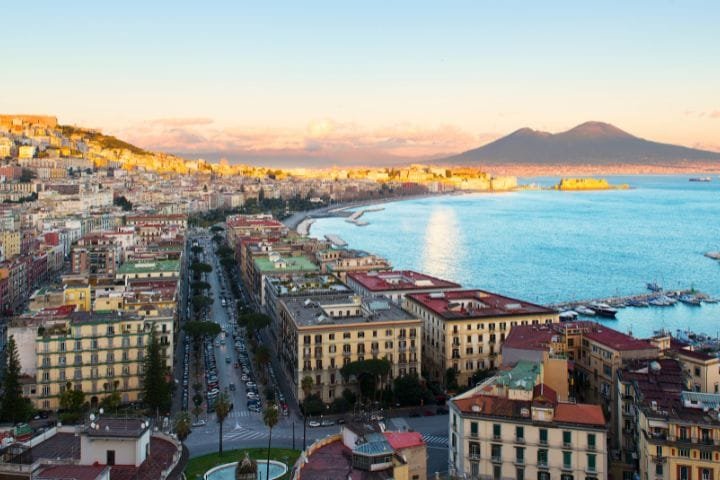
With two to three weeks, you can really dive deep into regional differences and experience Italy’s incredible diversity:
Northern Italy Focus (Days 1-7):
- Milan fashion and business sophistication
- Lake District romanticism and villa culture
- Dolomites mountain adventures and alpine scenery
- Venice’s unique lagoon environment and maritime history
Central Italy Immersion (Days 8-14):
- Florence Renaissance art and architectural mastery
- Tuscany wine country exploration and cooking classes
- Rome ancient history and the modern Italian capital’s energy
- Umbria hidden hill towns and truffle experiences
Southern Italy Discovery (Days 15-21):
- Naples authentic pizza culture and incredible energy
- Amalfi Coast dramatic coastlines and luxury resort culture
- Sicily cultural crossroads and unique island identity
- Sardinia pristine beaches and ancient archaeological sites
This timeframe lets you slow down and experience genuine regional differences instead of just checking famous sites off your list. You’ll understand why we Italians are so passionate about our local identities.
Italy Themed Itineraries: Tailored to Your Passions
Family-Friendly Adventure: Rome gladiator history captivates kids of all ages, Florence Duomo climb becomes an exciting challenge, and Lake Garda offers swimming and outdoor activities perfect for families. Skip the intense art museum marathons for interactive experiences, gelato stops, and destinations where children can actually run around.
Romantic Escape Route: Lake Como villa gardens and private boat rides, Tuscany wine tastings in vineyard settings with sunset views, Rome evening strolls and candlelit dinners in hidden piazzas, Amalfi Coast dramatic scenery and luxury hotels with infinity pools overlooking the Mediterranean.
Food and Wine Obsession: Emilia-Romagna region for Bologna pasta-making classes, Parma ham producers, and Modena traditional balsamic tastings; Tuscany Chianti wine tours with family winemakers; Rome traditional cuisine exploration and local market tours; Campania for authentic Neapolitan pizza and buffalo mozzarella in its birthplace.
Off-the-Beaten-Path Discovery: Skip major cities entirely – explore Matera cave dwellings in Basilicata, Alberobello trulli houses in Puglia, lesser-known Umbrian hill towns where tourists rarely venture, and dramatic Puglia coastline with pristine beaches and authentic fishing villages.
Personal recommendation from decades of experience: The themed approach often creates better memories than trying to see everything. You’ll have deeper cultural immersion and way better stories to tell when you get home.
How to Get Around Italy?
As someone who has taken literally hundreds of train journeys, driven countless kilometers of Italian highways, and helped friends navigate our transportation system for years, here’s the real scoop – the best option totally depends on your itinerary and comfort level.
Italy Trains: The Italian Way to Travel
Honestly, trains are usually your best bet for intercity travel, and I say this as someone who commutes regularly between Milan, Rome, and Florence. Italy’s high-speed rail network is genuinely fantastic – I can get from my home in Florence to Milan in 1h 58m, and the trains are more comfortable than most airplanes.
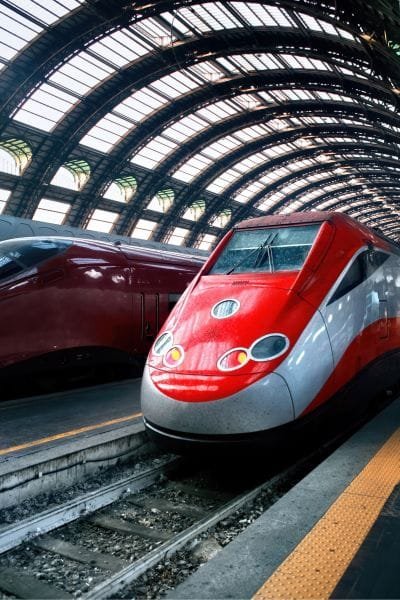
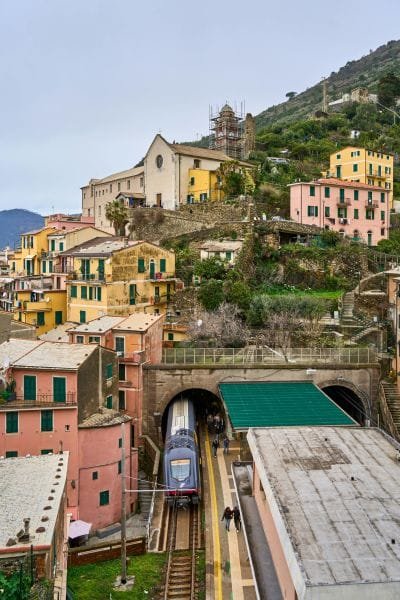
Why trains work so brilliantly here:
- Drop you directly in city centers, not airports 30km outside town
- No security theater or baggage weight restrictions
- Comfortable seats with actual legroom and power outlets
- Incredible scenery, especially through Tuscany and Umbria countryside
- Reliable schedules despite what outdated stereotypes suggest
Train operators you’ll encounter:
- Trenitalia: Our national railway with the most extensive route network
- Italo: Private competitor, often slightly cheaper with modern trains
- Regional services: Slower but super affordable for shorter distances
Italy Rail Pass vs Individual Tickets:
Unless you’re doing serious train travel (like 8+ long journeys), individual tickets usually work out cheaper and give you way more flexibility. I always book online or at station machines – popular routes during peak times can sell out, but there’s usually availability if you’re flexible with timing.
Last month, I helped my American friends plan a Rome-Florence-Venice trip entirely by high-speed train. They were absolutely amazed by how smooth and stress-free the experience was compared to their previous European budget airline adventures.
Italy Rental Cars: Freedom with Italian Complications
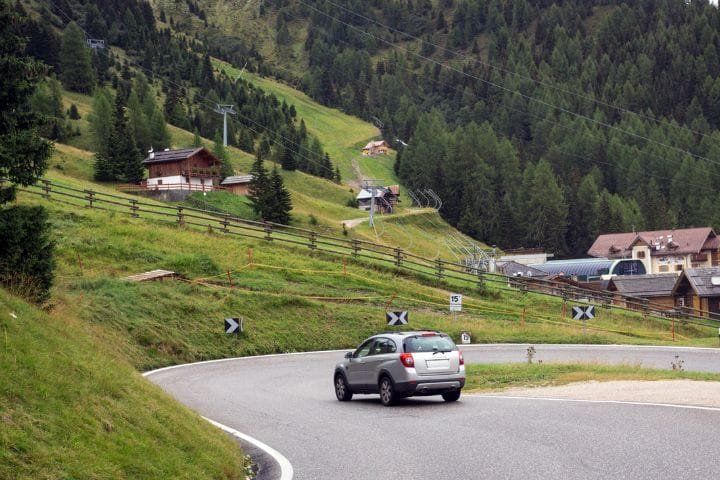
Renting a car gives you incredible flexibility, especially for exploring our countryside regions. Growing up, family road trips through Tuscany and Umbria taught me that sometimes the journey between destinations is way more beautiful than the destinations themselves.
When cars make perfect sense:
- Tuscany wine country exploration with spontaneous winery stops
- Multiple small hill towns in regions like Umbria or Le Marche
- Amalfi Coast driving (though that coastal road will seriously test your nerves)
- Dolomites hiking access where public transport is limited
- Sicily road trip or Sardinia island exploration
Italian driving realities I absolutely need to warn you about:
ZTL Zones (Zona Traffico Limitato) – The Expensive Trap:
- Historic city centers restrict car access with camera-monitored zones
- Automatic fines of €100+ that arrive months later at home
- Even GPS systems sometimes don’t warn you properly
- Always research your hotel’s exact location and parking before driving anywhere near city centers
Parking challenges:
- Parking in Historic centers: expensive when available, impossible during peak season
- Rural areas: usually abundant and completely free
- Always check local parking regulations and time limits
Italian driving culture:
- More assertive and expressive than most countries expect
- Lots of animated gesturing (it’s cultural communication, not road rage)
- Highway speeds can be… let’s say enthusiastic
- Lane discipline is more of a suggestion than a rule
My German cousin was terrified driving through Naples traffic, but absolutely loved cruising through peaceful Tuscan countryside – it really depends on your comfort level and the specific regions you’re exploring.
Italy Domestic Flights: Sometimes Worth the Time Savings
For long north-south routes or reaching our islands, flying can save significant travel time. Milan to Palermo takes just 1.5 hours by air versus a full day combining trains and ferries.
When flying makes sense:
- Mainland to Sicily or Sardinia island connections
- Northern Italy to deep southern regions like Calabria
- Time-limited itineraries where every day counts
- Off-season periods when fewer trains and ferries operate
Flight downsides to consider:
- Airports located outside city centers (factor in transfer time and costs)
- Baggage restrictions and weight limits
- Security delays that can eat into time savings
- Weather delays are more common than train schedule disruptions
Italy Ferry Connections: Island Adventures
Getting to our gorgeous islands requires ferry travel, which is generally reliable, comfortable, and part of the Mediterranean adventure. I’ve taken countless ferries to Sicily, Sardinia, and smaller islands – it’s genuinely enjoyable when you’re not in a rush.
Main ferry routes:
- Multiple mainland ports to Sicily (Naples, Villa San Giovanni, Reggio Calabria)
- Mainland to Sardinia (Civitavecchia-Olbia route most popular with tourists)
- Island hopping in areas like Cinque Terre and smaller archipelagos
- International connections from France to Sardinia, Greece to southern Italy
Book ferry tickets ahead during summer months – Italians vacation on our islands too, and popular routes definitely sell out during peak season.
Transportation Apps I Actually Use Daily
Essential apps for smooth Italian travel:
- Trenitalia: Train schedules, bookings, real-time platform updates
- Rome2Rio: Comprehensive route planning between any two destinations
- Moovit: Local public transport that works in all major Italian cities
- Google Maps: Excellent for both driving directions and walking routes
- Waze: Better for real-time traffic updates and speed camera warnings
Train vs Car in Italy: The Real Local Perspective
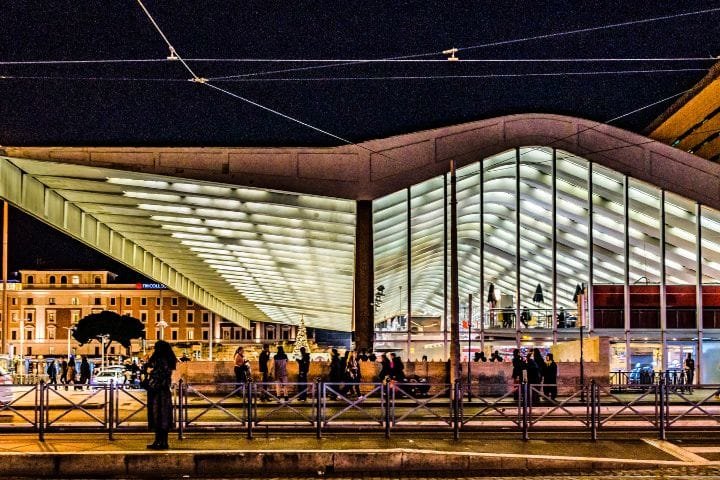
Trains absolutely win for:
- Major city connections where parking is a nightmare or impossible
- Relaxing while traveling instead of stressing about traffic
- Environmental impact and carbon footprint considerations
- Often faster door-to-door when you factor in parking and walking time
Cars definitely win for:
- Rural exploration in regions where trains simply don’t reach
- Multiple small towns in a single day without schedule constraints
- Traveling with lots of luggage or shopping purchases
- Reaching hiking trailheads and remote natural areas
- Going at your own pace without timetable pressure
Honestly, most smart travelers combine both transportation methods – high-speed trains between major cities for efficiency, then strategic car rentals for specific regions like Tuscany or southern Italy, where public transport is limited. That’s exactly the approach I recommend to visiting friends, and it works perfectly.
How much does it cost to travel to Italy?
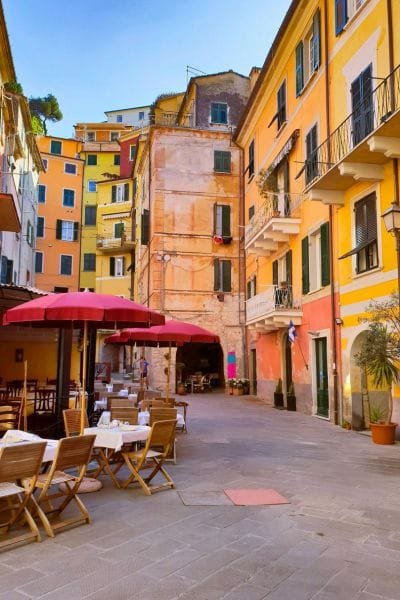
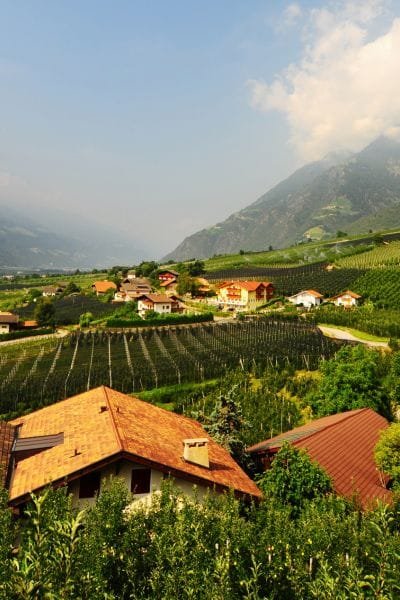
Let me give you the real numbers here – Italy can range from genuinely backpacker-friendly to seriously luxurious depending on your choices and timing:
Italy Daily Budget Reality Check
Budget Travel (€40-60 per day):
- Hostels or basic guesthouses (€20-40/night)
- Local restaurants, street food, and market shopping
- Public transport and lots of walking
- Free attractions like churches, piazzas, and neighborhood wandering
I have friends who’ve successfully done this approach, especially during shoulder season. The secret is eating where locals eat and avoiding anything within two blocks of major tourist attractions.
Mid-Range Comfort (€100-150 per day):
- Three-star hotels or nice Airbnbs (€60-120/night)
- Mix of local trattorias and some nicer restaurant experiences
- High-speed trains between cities for comfort and time savings
- Major paid attractions plus occasional guided tours
This gives you a really comfortable Italian experience without financial stress – it’s honestly how most of my visiting friends prefer to travel.
Luxury Experience (€200+ per day):
- Four and five-star hotels in prime locations (€150-500+/night)
- Excellent restaurants, wine tastings, and premium dining experiences
- Private transfers, guided tours, and exclusive access experiences
- Premium activities like cooking classes and luxury spa treatments
Some luxury hotels in places like Lake Como or Positano can easily cost €500+ per night alone during peak season – the sky’s really the limit if you want to splurge.
Cost Breakdown by Category
Accommodation varies dramatically by location and season:
- Budget hostels and guesthouses: €20-40/night
- Mid-range hotels: €80-150/night
- Luxury hotels: €200-500+/night
- Airbnb rentals: Often excellent value, especially for longer stays
- Agriturismos (farm stays): €60-120/night with incredible authentic experiences
Food costs depend entirely on where and how you eat:
- Coffee and cornetto breakfast: €3-5 at local bars
- Lunch at neighborhood trattoria: €8-15 for satisfying meals
- Dinner at good restaurant: €25-40 per person with wine
- Fine dining experiences: €80-100+ per person
- Street food and market vendors: €2-6 per item
lunch menus (menu del giorno) at nice restaurants cost way less than dinner service at the exact same places.
Transportation costs across different methods:
- High-speed trains between major cities: €25-80 depending on distance
- Regional trains: Much cheaper (€8-25 for similar routes but slower)
- Rental cars: €25-40/day plus fuel and highway tolls
- City public transport: €1.50-2 per ride, day passes €4-7
- Taxis for typical city rides: €10-25
Activity and attraction expenses:
- Church visits: Usually free (small donations appreciated)
- Major museums and archaeological sites: €10-25 entrance fees
- Guided tours: €30-80 per person depending on length and exclusivity
- Cooking classes: €50-150 for hands-on experiences
- Wine tastings: €25-100 depending on region and winery prestige
Money-Saving Strategies That Actually Work
Having lived here forever and watched budget-conscious friends succeed, here are strategies that genuinely save money:
Timing strategies for significant savings:
- Visit May, June, September, and October for shoulder season pricing
- Avoid July-August peak season markups (sometimes 50%+ higher)
- Book summer accommodation well in advance for better rates
Food money-savers locals use:
- Aperitivo culture: substantial free food with drinks between 6-8 PM
- Lunch specials at nice restaurants cost fraction of dinner prices
- Local food markets for fresh ingredients and prepared foods
- Coffee standing at bars (€1) versus sitting at tables (€3-4)
Sightseeing savings that add up:
- Many churches contain world-class art completely free
- City tourist cards often include transport plus skip-the-line attraction access
- Free walking tours operate in most major cities (tip-based)
- Museum evening hours sometimes offer reduced admission
Local insider tricks I share with visiting friends:
- Fill water bottles at public fountains (excellent quality water everywhere)
- Shop at local supermarket chains like Coop, Conad, or Esselunga
- Take slower regional trains for scenic routes at a fraction of high-speed costs
- Stay in neighborhoods slightly outside historic centers for much better prices
Hidden Costs to Budget For
From personal experience helping friends avoid surprises, these costs definitely add up:
Accommodation extras that catch people off-guard:
- Tourist tax: €1-5 per person per night in most cities
- Resort fees at some higher-end hotels
- City center parking: €20-40/day when available
Dining surprises that are totally normal:
- Coperto (table service charge): €1-3 per person at restaurants
- Bread and water charges are included in coperto (not separate scams)
- Higher menu prices at restaurants immediately near major attractions
Transportation gotchas to avoid:
- ZTL fines for driving in restricted historic zones: €100+ that arrive months later
- Highway tolls add up quickly on longer drives (budget €0.07 per kilometer)
- Airport transfer costs: €30-50 from airports to city centers
Regional Price Variations
Having lived in different parts of Italy, costs vary significantly by region:
Most expensive areas:
- Venice, especially anything near San Marco Square
- Amalfi Coast during the peak summer season
- Milan city center, particularly Brera and Navigli districts
- Lake Como resort towns
Best value regions:
- Southern Italy (Puglia, Calabria, Sicily interior)
- Smaller towns and rural areas throughout the country
- Northern cities outside Milan (Bologna, Verona, Padova)
- Any destination during genuine off-season
Rome and Florence fall somewhere in the middle price-wise. They’re expensive near major tourist attractions but totally reasonable in residential neighborhoods where locals actually live, shop, and eat daily.
My honest recommendation? Budget for mid-range comfort (€100-150/day) and you’ll have the flexibility to splurge on special experiences while staying comfortable throughout your Italian adventure. Trust me, the memories from those splurge moments – whether it’s an incredible dinner, a private wine tasting, or a luxury hotel night – will last way longer than the extra money spent.
Essential Italy Travel Resources
Before you dive into the details of your trip, check out these handpicked guides that cover the big questions every traveler asks when planning their Italian adventure:
👉 Best Time to Visit Italy – Seasons explained with festivals, weather tips, and crowd levels.
👉 How to Get Around Italy – Trains vs. cars vs. buses: what works best for your trip.
👉 7 Days Italy Itinerary: Perfect First-Timer’s Guide – A complete one-week plan with Rome, Florence, Venice & options for side trips.
👉 Italy Travel Costs: Budget, Mid-Range & Luxury – Realistic breakdown of what you’ll spend on food, hotels, transport & activities.
👉 Best Beaches in Italy – A guide to the most stunning coastal spots, from Amalfi to Sardinia.
Get our FREE Italy
Travel Guide
E-Book
This printable guide is your ultimate companion for exploring Italy, with insider tips, detailed itineraries, transportation advice, must-see attractions, and more.

Where to Stay in Italy?
As someone who’s lived in multiple Italian cities and hosted countless visitors over the years, location makes such a huge difference in your experience – pick the right neighborhood and you’ll feel like a local, choose poorly and you’ll spend half your vacation commuting to where the real action happens. Let’s explore where to stay in Italy, city by city— from chic hotels in Milan to cozy guesthouses in Florence and stunning canal-side stays in Venice.
Where to Stay in Rome?
Neighborhood Guide from a Local Perspective
Historic Center (Centro Storico): Walking distance to Pantheon, Trevi Fountain, Spanish Steps, and incredible restaurants that come alive after dark. You’ll pay premium prices, but the convenience and atmosphere are totally worth it for first-time visitors who want everything at their fingertips.
When I bring friends here, they’re constantly amazed by stumbling upon incredible Roman architecture just walking back from dinner.
Hotel Recommendations:
Hotel De’ Ricci
The Liberty Boutique Hotel
Trastevere: Feels genuinely like a medieval village within the modern city, with cobblestone streets, family-run trattorias, and a lively nightlife scene, especially on weekends. It’s across the Tiber River from the main tourist sites, but easily walkable or a quick tram ride to anywhere.
Hotel Recommendations:
citizenM Rome Isola Tiberina
Hotel Trecento
Monti: Hip neighborhood near the Colosseum with boutique shops, natural wine bars, and that authentic Roman neighborhood vibe without feeling overly touristy. Great balance of central location and genuine local character.
Hotel Recommendations:
Hotel Forum
Hotel Centro Cavour
Vatican Area (Prati): Perfect if Vatican Museums are your absolute priority, with excellent restaurants and more residential Roman feel. Easy metro access to the rest of the city, plus you can walk to St. Peter’s for sunrise photos without crowds.
Hotel Recommendations:
NH Collection Roma Giustiniano
Hotel Diplomatic
Where to Stay in Florence?
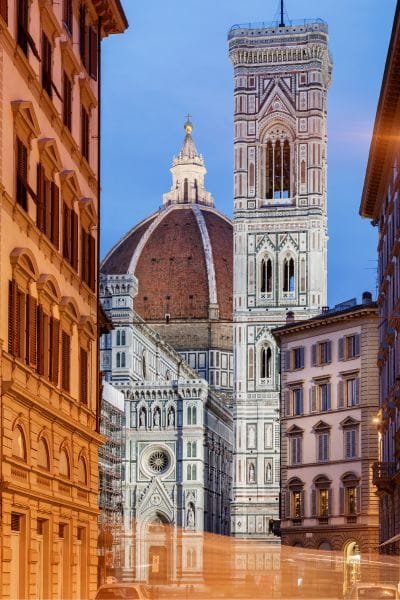
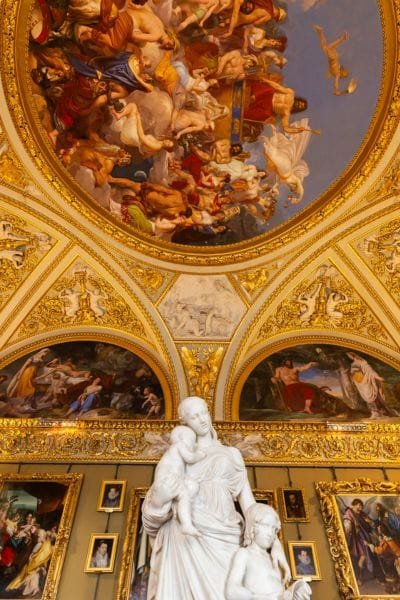
My Home City Recommendations
Historic Center (Centro): Everything’s walkable from here – Duomo, Uffizi, Ponte Vecchio all within a few blocks. Expect tourist crowds but maximum sightseeing efficiency. Higher prices but incredible convenience for short stays.
Hotel Recommendations:
Orto De Medici Hotel
Hotel Paris
Oltrarno: Across the Arno River with authentic artisan workshops where craftspeople still make leather goods and jewelry using traditional techniques. Local restaurants and bars where Florentines actually hang out after work, still within walking distance to major sites but with a more authentic atmosphere.
Living here my entire life, Oltrano is where I take all my visiting friends for authentic Florentine evening experiences.
Hotel Recommendations:
Hotel La Scaletta Al Ponte Vecchio
Hotel Ferrucci Firenze
Santa Croce: Excellent mix of central location and genuine local life, with the beautiful Santa Croce church and square plus outstanding restaurants and aperitivo bars. Perfect balance for travelers wanting both major sights and local culture.
Hotel Recommendations:
Hotel Balestri
Hotel Jane
Where to Stay in Venice?
Island Neighborhood Guide
San Marco: Most central location, literally steps from St. Mark’s Square, but most expensive and most crowded area. You’ll be surrounded by tourists and tourist-priced everything, but ultimate convenience for sightseeing.
Hotel Recommendations:
Hotel Bella Venezia
Hotel Dell’Opera
Castello: More residential feeling while still being totally central to major attractions. Grthineat authentic restaurants and that magical feeling of discovering “hidden” Venice while remaining walkable to all must-see sites.
Hotel Recommendations:
Hotel Bisanzio
Albergo Commercio e Pellegrino
Dorsoduro: Artsy area with incredible museums, galleries, and university energy. The Zattere waterfront is absolutely perfect for evening walks with locals. Great for art lovers wanting cultural immersion.
Hotel Recommendations:
Avani Rio Novo Venice Hotel
Belle Arti Hotel
Cannaregio: Most authentic residential area where Venetians actually live year-round. Local food markets and neighborhood restaurants serving cicchetti without tourist markups. A bit further from major sights but still totally walkable and way more affordable.
Growing up visiting Venetian relatives, Cannaregio always felt like where real Venetians live and work, not just cater to visitors.
Hotel Recommendations:
Pesaro Palace
A La Locanda di Orsaria
Where to Stay in Milan?
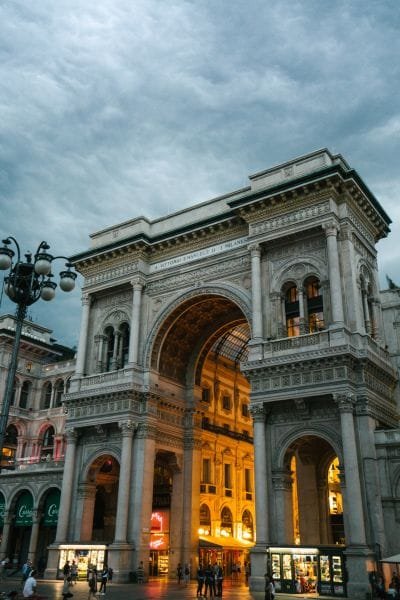
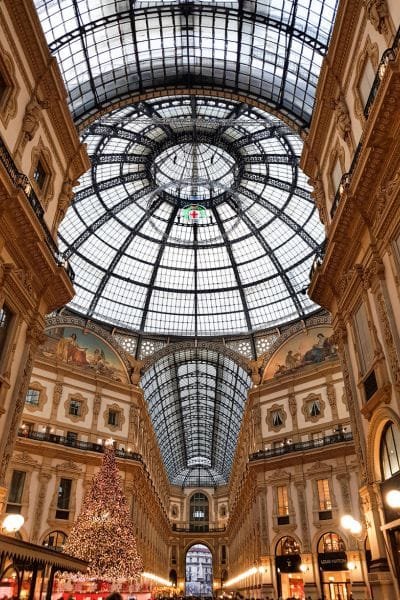
City of Culture & Fashion
Brera: Designer district with art galleries, boutique shopping, and sophisticated aperitivo bars. Central to both business attractions and cultural sites. Perfect for fashion lovers and business travelers wanting stylish experiences.
Hotel Recommendations:
UNA Hotels Cusani Milano
Hotel Rio
Navigli: Canal district that absolutely comes alive at night with restaurants, bars, and live music venues. This is where Milan’s famous aperitivo culture really shines. Best neighborhood for nightlife lovers and younger travelers.
Hotel Recommendations:
Art Hotel Navigli
B&B Hotel Milano Sant’Ambrogio
Duomo Area: Most central for sightseeing and high-end shopping, though expect tourist crowds and higher prices. The ultimate convenience factor for short stays focused on major attractions and shopping.
Hotel Recommendations:
Galleria Vik Milano
Maison Milano | UNA Esperienze
Accommodation Types in Italy: What Works for Different Travelers
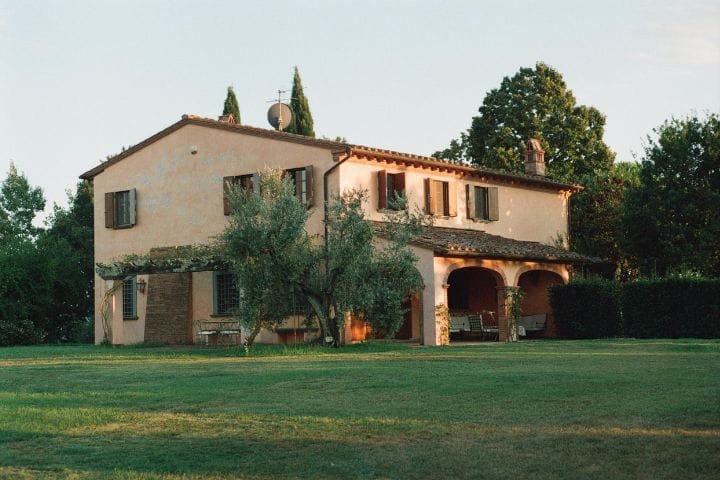
Hotels vs Airbnb considerations:
Hotels provide:
- Consistent daily service and housekeeping
- Concierge assistance with local recommendations and bookings
- Central locations often in historic buildings
- Reliable amenities and problem resolution
Airbnbs offer:
- More space, especially valuable for families
- Kitchen access for breakfast and snacks (saves money)
- Local neighborhood experiences in residential areas
- Often better value for stays longer than a few days
Agriturismos (Farm Stays): Unique experiences in rural areas throughout Tuscany, Umbria, and other regions. Homemade meals using ingredients grown on the property, beautiful countryside settings, and wine tastings are often included. Perfect for couples and families wanting authentic rural Italian experiences.
I’ve stayed at family friends’ agriturismos in Chianti region – waking up to vineyard views and homemade breakfast using eggs from property chickens is pretty magical.
Boutique vs Chain Hotels: Italy has incredible boutique hotels with genuine character and local charm, especially historic palazzos converted to luxury accommodations. Chain hotels provide consistency and reliability, but way less personality and cultural immersion.
Practical Considerations by Traveler Type
Solo Travelers: Stick to well-connected neighborhoods with good public transport access and evening activity nearby. Historic centers are generally very safe and lively, with plenty of other travelers and locals around.
Families: Look for accommodations with kitchen access helpful for breakfast and snacks, plus nearby parks or playgrounds where kids can actually run around. Many agriturismos are incredibly family-friendly with outdoor space and farm animals.
Couples: Romantic settings like canal views in Venice, historic palazzos in Florence, or vineyard views in Tuscany create those special moments absolutely worth the extra cost for memorable experiences.
Business Travelers: Prioritize locations near transport hubs with reliable high-speed WiFi, business districts in major cities, and hotel services more important than local neighborhood character.
From personal experience hosting countless visitors over the years, the neighborhood you choose literally shapes your entire Italian experience – invest time in getting this decision absolutely right, and you’ll feel like you belong here rather than just visiting.
What to Eat in Italy? (Italian Food By Region)
Growing up eating my nonna’s cooking in Tuscany, spending my university years discovering Bologna’s incredible food scene, and now living between different regions, let me tell you – food isn’t just sustenance here; it’s culture, family history, and regional pride all wrapped up in one absolutely incredible culinary experience.
Italy’s Regional Cuisines are way more diverse than most people realize.
What to Eat in Bologna?
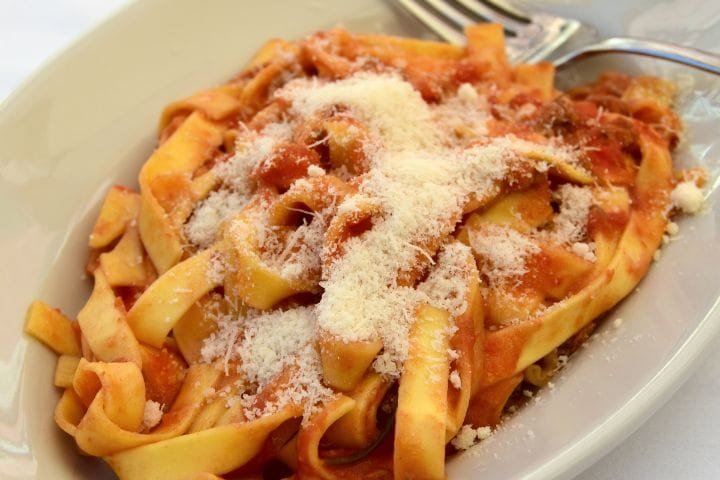
Bologna (My Personal Food Paradise): This is where I learned that pasta isn’t just pasta – it’s pure artistry passed down through generations. Bologna gave the world Bolognese sauce, and here’s something most tourists don’t realize: we never, ever put it on spaghetti. It goes with fresh tagliatelle, always.
- Regional specialties: Hand-rolled fresh pasta, aged Parmigiano-Reggiano, Prosciutto di Parma
- Must-try dishes: Tortellini in brodo, authentic Bolognese with tagliatelle, Tagliatelle al Ragù, Mortadella, aged traditional balsamic from Modena
- Local secret: The best fresh pasta shops often close by 1 PM when they sell out
I spent my university years in Bologna watching nonnas make pasta by hand in tiny family restaurants, and that’s when I truly understood what authentic Italian food culture really means.
What to Eat in Naples?
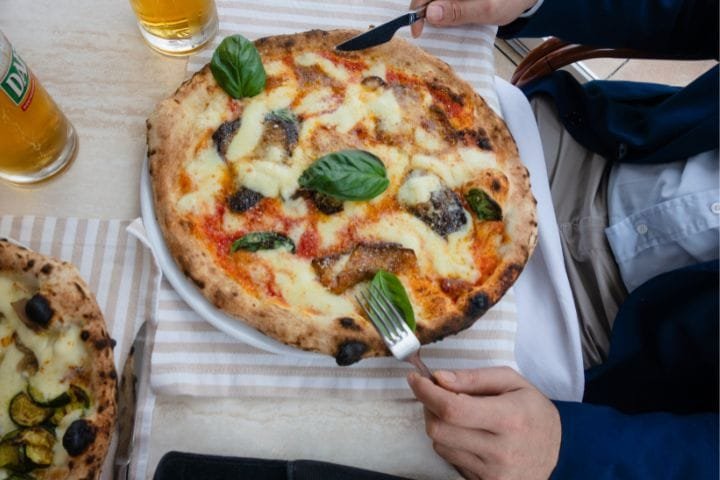
Naples (Pizza’s True Birthplace): Naples invented pizza, and honestly, nothing you’ve eaten elsewhere even comes close to authentic Neapolitan pizza. My friends from Naples get genuinely offended by thick-crust American-style pizza – here it’s all about those perfect charred, puffy edges and simple, pristine toppings.
- Regional specialties: Neapolitan pizza with buffalo mozzarella, San Marzano tomatoes, fresh basil
- Must-try experiences: Pizza Margherita at historic pizzerias, pasta alle vongole, sfogliatelle pastries for breakfast
- Local secret: The best pizzerias often look like absolutely nothing from the outside
What to eat in Tuscany?
Tuscany (My Childhood Flavor Memories): Growing up spending every summer at my nonna’s house near Siena, I learned that Tuscan cuisine is fundamentally about letting incredible ingredients speak for themselves. Simple preparations, exceptional quality products, amazing wine that pairs perfectly with everything.
- Regional specialties: Bistecca alla Fiorentina, Chianti Classico wine, wild boar preparations
- Must-try dishes: Ribollita (hearty bread soup), pici pasta with wild boar sauce, fresh pecorino cheese, prosciutto, lampredotto sandwich (street food)
- Local rule: Never, ever ask for cheese on seafood pasta – locals will absolutely judge you
What to Eat in Sicily?

Sicily (Where Culinary Cultures Beautifully Collide): Sicilian friends taught me their island cuisine reflects literally 3,000 years of cultural influences. Arabic spices, Greek cooking techniques, Spanish ingredients, Italian pasta traditions – it’s like traveling through Mediterranean history on your plate.
- Regional specialties: Arancini rice balls, fresh cannoli (sweet pastry with ricotta cream), granita, incredible seafood
- Must-try experiences: Pasta alla norma (pasta with tomato sauce and fried eggplant), caponata vegetable stew, cassata dessert, Street food such as panelle (chickpea fritters) and sfincione(thick, Sicilian-style pizza)
- Local tradition: Granita with warm brioche is the traditional Sicilian breakfast
Italian Dining Customs: Don’t Be That Tourist
Let me share the unwritten rules that’ll help you blend in with locals instead of standing out as an obvious tourist:
Coffee Culture Rules (Seriously Important):
- Cappuccino is strictly breakfast only – ordering after lunch immediately marks you as foreigner
- Espresso after meals aids digestion (that’s why it’s small, strong, and quick)
- Always stand at the bar for coffee – costs €1 standing, €3-4 sitting at tables
- Never order decaf – Italians genuinely don’t understand why you’d want coffee without caffeine
Growing up, my nonno (grandfather) would literally shake his head watching tourists order cappuccino after big dinners, muttering “It’s like eating breakfast for dessert!”
Meal Timing and Structure:
- Lunch starts around 1 PM, dinner rarely before 8 PM in most regions
- Many restaurants close 3-7 PM between lunch and dinner service
- Proper meal structure: Antipasti, primi, secondi, dolci – though you don’t need to order everything
- Never rush dining – meals are social time, family time, relationship time
Restaurant Etiquette That Matters:
- Coperto (table charge): €1-3 per person, completely standard, not a tourist scam
- Bread and water charges: Normal and included in coperto fee
- Aperitivo culture: 6-8 PM drinks with substantial free food that can substitute a light dinner
- Tipping expectations: Round up or leave small change, 20% American-style tips actually make servers uncomfortable
Must-Try Dishes by Region (Local Recommendations)
Rome (Where I Learned to Love Culinary Simplicity):
- Carbonara: Eggs, aged pecorino cheese, guanciale – absolutely never cream!
- Cacio e Pepe: Just cheese and freshly cracked pepper, deceptively harder to make perfectly than it appears
- Supplì: Fried rice balls filled with mozzarella, perfect Roman street food
- Pizza al taglio: Sold by weight, completely different style from Neapolitan round pizzas
My Roman friends are absolutely passionate about these dishes being prepared correctly – don’t even think about asking for chicken in your carbonara.
Florence (My Home City Classics):
- Bistecca alla Fiorentina: Massive T-bone steak, always served rare
- Ribollita: Hearty bread and vegetable soup, perfect for cool weather
- Lampredotto: Tripe sandwich for genuinely adventurous eaters only
- Schiacciata: Traditional Tuscan flatbread, absolutely perfect for picnics
Venice (Lagoon Specialties):
- Cicchetti: Small plates eaten standing at traditional wine bars
- Risotto with fresh seafood: Takes full advantage of lagoon location
- Baccalà mantecato: Creamy whipped cod spread on polenta
- Spritz aperitivo: The drink that conquered all of Italy
Milan (Renaissance City Food Culture)
- Risotto alla Milanese: Golden with saffron, creamy and perfect
- Cotoletta alla Milanese: Breaded veal cutlet, Milan’s signature dish
- Panettone: Christmas bread that’s honestly a year-round obsession here
- Aperitivo culture: We take this social dining tradition more seriously than anywhere
Gelato Etiquette and Quality Recognition
As someone who’s eaten gelato across Italy for literally decades, here’s how to spot authentic quality:
Authentic gelato signs:
- Natural colors only (bright artificial green pistachio is fake)
- Covered display cases (prevents ice crystals and freezer burn)
- Not stacked impossibly high in containers (real gelato is dense)
- Made fresh daily with seasonal ingredient variations
Proper gelato etiquette:
- Small portions are completely normal (focus on quality over quantity)
- Maximum two flavors in a small cup (more than that is tourist behavior)
- Eat quickly – authentic gelato melts fast in warm weather
- Don’t ask for samples of every single flavor
Best regional gelato experiences:
- Sicily: Incredible pistachio and fresh lemon flavors using local ingredients
- Rome: Traditional flavors executed to absolute perfection
- Florence: Creative combinations featuring local Tuscan ingredients
Food Markets in Italy and Local Shopping Wisdom
Every Italian city has incredible food markets where locals actually shop daily. Here’s where to go for authentic experiences:
Essential markets to visit:
- Rome: Campo de’ Fiori (touristy but excellent quality), Testaccio (where Romans shop)
- Florence: Mercato Centrale (amazing prepared foods upstairs), Sant’Ambrogio (locals’ market)
- Bologna: Mercato delle Erbe (where university students and locals shop daily)
- Palermo: Ballarò market (incredible street food and authentic Sicilian energy)
Smart market shopping tips:
- Always go early in the morning for the absolute best selection
- Bring small bills and coins (many vendors prefer cash)
- Never touch produce unless the vendor invites you
- Buy whatever’s in peak season for best flavors and prices
- Perfect source for picnic supplies and authentic local ingredients
From growing up shopping at markets with my nonna (grandmother), I learned that market vendors become your friends when you show genuine interest in their products and respect their expertise – they’ll guide you to the best seasonal choices and often share family recipes.
Top Things to Do in Italy (Landmarks & Hidden Gems)
As someone who’s lived here my entire life and experienced our country through both local and visitor eyes, I can tell you the real magic happens when you go way beyond the standard sightseeing checklist and discover Italy the way we locals actually experience it.
Best Things to Do in Rome
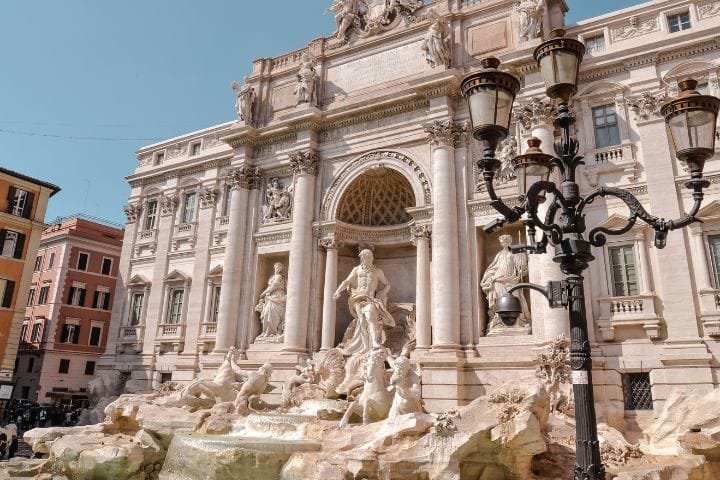
Rome’s Ancient Wonders: The Colosseum is absolutely incredible, but here’s the insider approach – combine it with the Roman Forum and Palatine Hill for the complete ancient Rome experience.
Book skip-the-line tickets months ahead, seriously. I’ve watched tourists wait 3+ hours in summer heat while people with advance tickets walk straight in.
The Vatican Museums and Sistine Chapel are unmissable, but book the earliest possible entry time (8 AM if available) to beat the crowds. I’ve been there at opening time with visiting family – you’ll practically have Michelangelo’s masterpiece to yourself for those first precious moments.
When it comes to things to do in Rome, few experiences rival standing beneath the Pantheon’s ancient dome or making a wish at the Trevi Fountain.
Visit the stunning Basilica di Santa Maria Maggiore, one of the city’s most important churches, and explore masterpieces at the Borghese Gallery. Climb the Spanish Steps for panoramic views of the Eternal City, then step back in time at the iconic Castel Sant’Angelo.
Things to Do in Florence: Renaissance Masterpieces
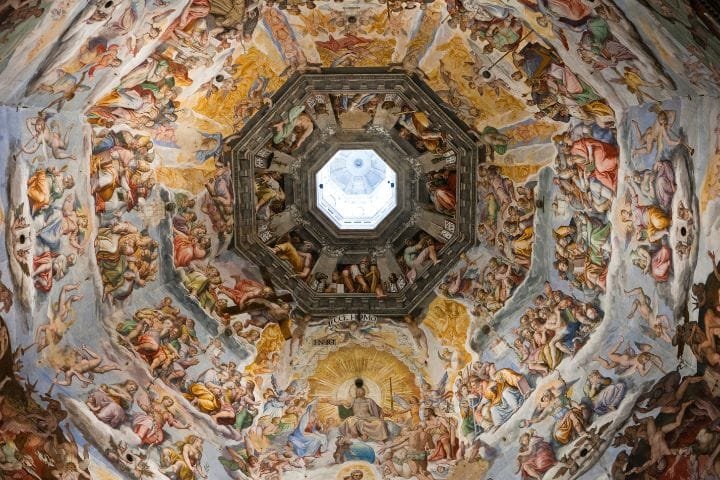
The Uffizi Gallery houses Botticelli’s Birth of Venus and countless Renaissance treasures, but you absolutely must book weeks or months ahead during peak season.
Climbing the Duomo dome provides incredible city views and architectural appreciation, though it’s definitely not for anyone with claustrophobia – 463 narrow steps in tight spaces.
Don’t miss the Accademia Gallery to see Michelangelo’s David in person, or stroll across the Ponte Vecchio, Florence’s iconic medieval bridge lined with jewelers. The Basilica of Santa Croce is another gem, home to the tombs of Galileo, Michelangelo, and Machiavelli.
The completely free sunset view from Piazzale Michelangelo is honestly spectacular and costs nothing — I take every visitor here for golden hour photos overlooking the entire Renaissance city.
Top Things to Do in Venice
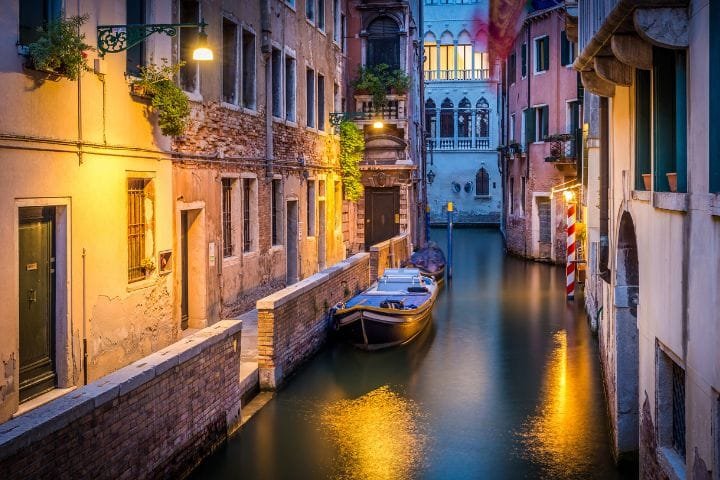
St. Mark’s Basilica and the Doge’s Palace showcase Venice’s incredible maritime history, but the real magic happens wandering the backstreet canals, where you’ll discover local life and hidden squares away from tourist crowds.
Stroll across the Rialto Bridge for postcard-perfect Grand Canal views, or explore the colorful island of Burano, famous for its rainbow houses and lace-making traditions. Hop over to Murano to watch master glassblowers at work, or escape the crowds on the Lido, a serene beach island perfect for a relaxed afternoon.
Art lovers shouldn’t miss the Peggy Guggenheim Collection, while opera fans can catch a performance at Teatro La Fenice, one of Italy’s most historic theaters.
And yes, gondola rides are touristy and expensive (around €80 for 30 minutes), but floating through quiet canals at sunset is genuinely magical. I’ve done it with visiting relatives, and even as a jaded local, there’s something absolutely enchanting about experiencing Venice from water level.
Natural Wonders in Italy: Diverse Landscapes
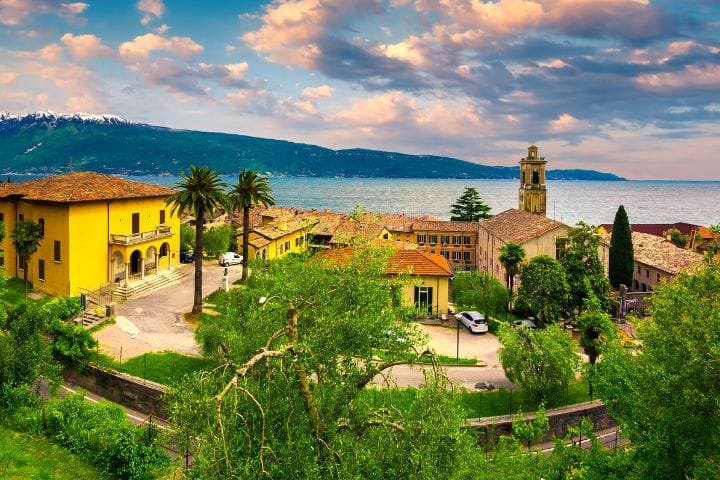
The Dolomites offer some of Europe’s most dramatic mountain scenery with hiking trails for every fitness level. The Seceda ridgeline and Alpe di Siusi meadows provide those incredible Instagram-worthy Alpine views, while traditional rifugios (mountain huts) serve hearty meals with panoramic vistas.
Growing up, family hiking trips here taught me that Italian landscapes can change dramatically within just hours – from Alpine meadows to jagged limestone peaks to pristine mountain lakes.
Cinque Terre connects five colorful coastal villages via hiking trails and regional trains. The villages get absolutely packed during summer, but the coastal hiking trail between towns offers spectacular Mediterranean views and an authentic fishing village atmosphere when you escape the crowds.
The Italian Lakes each have completely distinct personalities that locals appreciate differently:
- Lake Como: Villa gardens, elegant towns like Bellagio, celebrity spotting potential
- Lake Garda: Best swimming conditions, family-friendly beaches, water sports
- Lake Maggiore: Incredible botanical gardens on Borromean Islands, quieter, romantic atmosphere
Unique Activities: The Experience Economy
Truffle Hunting in Umbria and Piedmont combines outdoor adventure with incredible dining experiences. You’ll work with specially trained dogs to find these valuable fungi, then enjoy multi-course meals featuring your discoveries. It’s expensive but completely unique to this region.
Two years ago, I joined friends on a truffle hunt near Alba during peak season – watching the dogs work and then tasting fresh white truffles shaved over simple pasta was absolutely unforgettable.
Wine Tours in Tuscany, Piedmont, or Veneto regions go way beyond simple tastings. You’ll learn about terroir, meet actual winemaking families, and often enjoy meals paired with wines you literally cannot find anywhere else. The Chianti region offers the most accessible options from Florence.
Cooking Classes range from tourist-focused demonstrations to authentic experiences with local families. Bologna offers incredible pasta-making classes where nonnas teach traditional techniques, while southern regions focus on regional specialties like pizza-making in Naples.
Personal recommendation: Look for classes that include market visits and multiple courses – that’s where you’ll learn what Italian food culture really means beyond just recipes.
Italy Hidden Gems: Local Favorites
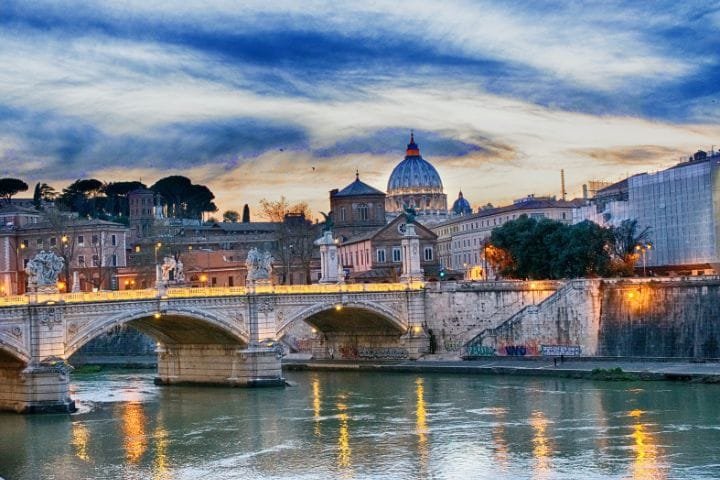
Roman Neighborhood Exploration: Skip the overcrowded tourist areas and wander through Monti, Trastevere, or Testaccio for authentic local life, incredible family-run restaurants, and beautiful architecture without the selfie-stick crowds.
I regularly walk friends through Testaccio district where Romans actually live and shop – the contrast with tourist-packed areas is remarkable, and the food is infinitely better and cheaper.
Florence’s Oltrarno District: Cross the river from the historic center to discover artisan workshops where craftspeople still make leather goods, jewelry, and art using techniques passed down through generations. The area has incredible restaurants and wine bars where Florentines actually gather after work.
Venice’s Castello District: Most tourists never venture here, but it’s where Venetians actually live year-round. You’ll find local food markets, neighborhood bars serving cicchetti, and authentic restaurants without tourist markups or multilingual menus.
Underground Rome: The city has incredible underground sites like San Clemente Basilica (three churches built literally on top of each other spanning 2,000 years) and various Catacombs that provide fascinating glimpses into early Christian Rome that most visitors completely miss.
Museum Passes and Practical Tips
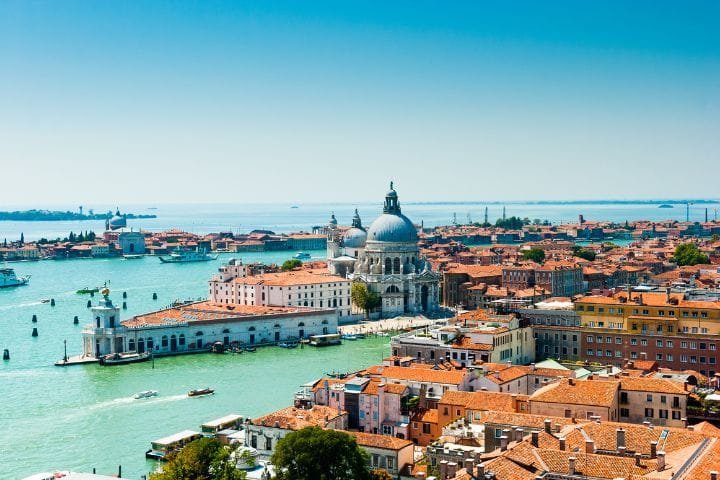
Smart ticketing strategies:
- Roma Pass: Includes public transport plus skip-the-line access to major attractions
- Florence Card: Essential during peak season when Uffizi books out months ahead
- Venice Museum Pass: Good value if you’re hitting multiple paid attractions
Best timing for popular attractions:
- Early morning (8-9 AM) or late afternoon avoid the worst crowds
- Many museums offer evening hours during summer with different atmospheres
- Winter visits mean shorter lines but reduced hours at some sites
Photography considerations:
- Many churches and museums restrict flash photography
- Sistine Chapel prohibits all photography (seriously enforced)
- Golden hour lighting (hour before sunset) makes everything look incredible
From decades of experience showing visitors around our incredible country, the most memorable experiences happen when you balance must-see landmarks with genuine local discoveries.
The tourists who leave happiest are those who appreciate both Michelangelo’s masterpieces and spontaneous conversations with local artisans – that’s when Italy really reveals its magic.
🧭 Discover More: Italy’s Must-See Highlights
Planning your trip and not sure where to start? Check out these in-depth guides to make the most of your Italian adventure:
👉 Best Places to Visit in Italy – from timeless cities like Rome and Venice to hidden regional gems.
👉 Best Things to Do in Italy – unique experiences, bucket-list activities, and insider tips to make your trip unforgettable.
👉 Best Cities to Visit in Italy – explore the most beautiful Italian cities and hidden gems.
👉 10 Cheapest Cities to Visit in Italy – budget-friendly travel guide to the most affordable destinations.
👉 11 Hidden Gem Cities in Italy – underrated cities that must be in your bucket list.
What to Pack for Italy? (By Season)
Packing for Italy is all about versatility and looking appropriately presentable – we Italians do notice style, and you’ll feel way more comfortable blending in rather than standing out.
Year Round Essentials For Italy
Comfortable Walking Shoes: You’ll be doing serious walking on ancient cobblestones, so absolutely leave brand-new shoes at home. Broken-in sneakers or quality walking shoes work perfectly – just avoid overly athletic styles when dining at nicer restaurants or visiting churches.
I’ve watched countless tourists struggle with Roman cobblestones in inappropriate footwear while locals glide by effortlessly in well-worn leather shoes or quality sneakers.
Layering Pieces for Unpredictable Weather: Italian weather can change quickly, especially during the shoulder seasons:
- Light cardigan or jacket for air conditioning and cool evenings
- Versatile scarf that doubles as a church shoulder covering and a style accessory
- Pieces that work for multiple occasions and weather conditions
Modest Clothing for Church Visits: Many churches require covered shoulders and knees for entry:
- Light scarf or shawl for quick shoulder coverage
- Pants or longer skirts for major religious sites throughout the country
- Respectful attire shows appreciation for sacred spaces
Essential Tech Items:
- Italy uses Type C and Type L electrical plugs
- Universal adapter with USB ports is most convenient for multiple devices
- Portable phone charger is absolutely essential for photography and GPS navigation
Spring and Fall Packing For Italy (March-May, September-November)
This is prime layering season with the most unpredictable weather patterns:
Essential clothing items:
- Light sweater or fleece for cool mornings and evenings
- Comfortable jeans or pants for extensive walking and variable temperatures
- Light waterproof jacket or compact umbrella (spring can be quite wet)
- Closed-toe shoes plus sandals for unexpectedly warm days
- Mix of short and long sleeves for temperature flexibility
Last April in Rome, I experienced everything from t-shirt weather to needing wool sweaters within the same week – strategic layering absolutely saved the day.
Italy Summer Packing (June-August)
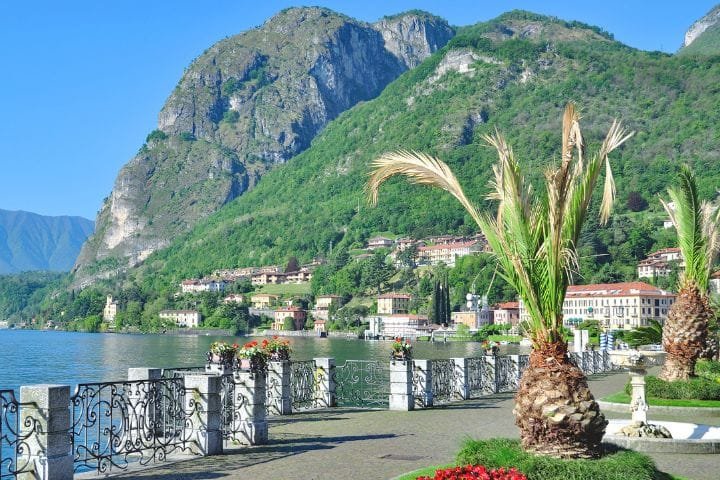
Lightweight, breathable fabrics are absolutely essential – Italian summers get seriously intense, especially in central and southern regions:
Must-have summer items:
- Cotton or linen shirts and dresses (synthetic fabrics become miserable in heat)
- Comfortable sandals for extremely hot pavement (Rome sidewalks get scorching)
- Quality sun hat and sunglasses – Mediterranean sun is genuinely intense
- Light cardigan for heavily air-conditioned museums and upscale restaurants
- Swimwear if beaches or lakes feature in your itinerary
- High-SPF sunscreen
Summer reality check: Working in Rome during July heat waves, I’ve seen tourists visibly struggling in synthetic clothing while locals wear flowing linen – fabric choice genuinely makes a huge difference in comfort.
Winter Packing For Italy(December-February)
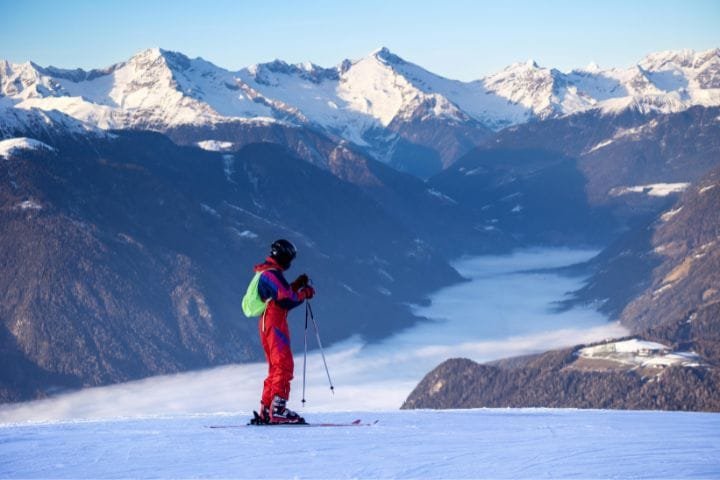
Warm layers plus waterproof outer protection for frequent rain:
Northern Italy winter essentials:
- Warm coat suitable for extended outdoor sightseeing
- Waterproof boots with excellent grip (northern cities can get icy)
- Gloves, a hat, and a warm scarf for mountain and Alpine regions
- Warm pants and long sleeves for cold temperatures
- Compact umbrella for frequent winter precipitation
Southern Italy winter considerations:
- Still pack warm layers – it gets cooler than most people expect
- Lighter coat sufficient for places like Naples, Sicily, southern regions
- Waterproof jacket essential for winter rain throughout the country
Regional Style Considerations
Milan Fashion Standards: This international fashion capital expects genuinely polished appearances:
- Avoid overly casual athletic wear in city center areas
- Aperitivo bars have informal but real dress expectations
- Investment in one really nice outfit absolutely pays off
- Italians definitely notice shoes – ensure yours are clean and appropriate
Rome’s Relaxed Elegance: More forgiving than Milan but still maintains Italian style standards:
- Avoid shorts and flip-flops in historic areas and when dining
- Churches throughout the city require respectful, modest attire
- Evening dining calls for smart casual presentation
- Comfortable but presentable remains the sustainable goal
Beach Town Casual Style: Much more relaxed atmosphere, but still maintains Italian aesthetic sense:
- Flowing fabrics and stylish swimwear rather than purely functional beach gear
- Attractive cover-ups for walking between beaches and restaurants
- Comfortable sandals are absolutely essential for hot sand and pavement
- Italian beach culture emphasizes quality and style over quantity
Small Town Respect: Rural areas particularly appreciate visitors who dress respectfully:
- Avoid revealing clothing in traditional, conservative communities
- Locals notice and genuinely appreciate the effort to look presentable
- Comfortable but modest clothing choices work best everywhere
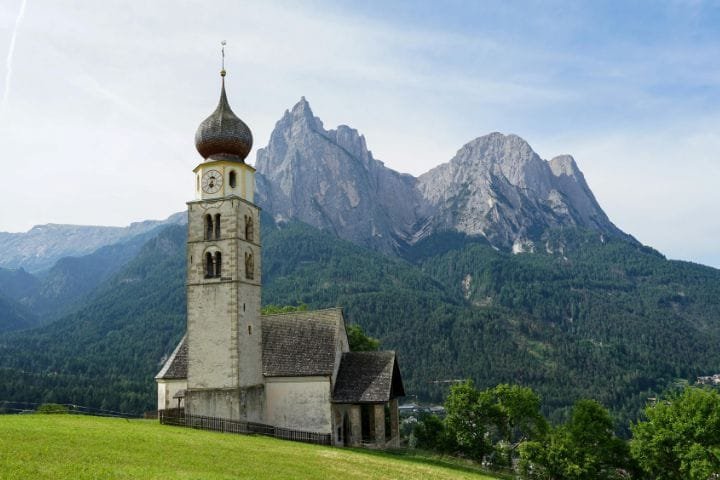
Must-Have Travel Accessories For Italy
Practical daily essentials:
- Small daypack: Perfect for sightseeing, market visits, carrying water bottles
- Reusable water bottle: Italy has excellent public fountains throughout all cities
- Secure crossbody bag: Keeps hands free and belongings secure in crowded areas
- Cash wallet with coins: Many small businesses still prefer cash payments
Technology essentials:
- Offline maps downloaded: Cellular coverage can be spotty in rural mountain areas
- Translation app with camera: Amazing for reading menus and historical signs
- Backup portable charger: Essential for navigation and constant photography
Comfort and convenience items:
- Comfortable walking socks: Prevents painful blisters during intensive sightseeing days
- Small first-aid kit: Band-aids and pain relievers for walking-intensive itineraries
- Travel-size laundry detergent: Useful for longer stays and washing essentials
Packing Strategy and Local Shopping
Smart packing philosophy:
- Bring fewer, higher-quality pieces that mix and match effectively
- Invest in genuinely comfortable walking shoes – your feet will absolutely thank you
- One really nice outfit opens doors to better restaurants and experiences
Italian shopping opportunities:
- Italian leather goods make excellent purchases and souvenirs
- Local markets offer beautiful scarves, accessories, and authentic crafts
- Leave adequate room in luggage for genuine Italian products
Practical laundry considerations:
- Many accommodations provide washing machines for longer stays
- Laundromats are available in larger cities and tourist areas
- Quick-dry fabrics are helpful for extended travel periods
From decades of experience dressing appropriately for Italy’s diverse climates and social expectations, the key is balancing personal comfort with respect for local customs and cultural norms – pack thoughtfully and you’ll feel confident exploring everything our beautiful country offers while fitting in naturally with local life.
What Not to Do in Italy? Mistakes to Avoid
As someone who has lived here my entire life and watched countless tourists make the same mistakes repeatedly, let me share the insider knowledge that’ll save you money, embarrassment, and maybe some well-deserved local eye-rolls.
Cultural Faux Pas That Immediately Mark You as a Tourist
The Sacred Cappuccino Rule: Seriously, don’t order cappuccino after 11 AM, and definitely never after meals. I’ve watched my Italian friends’ faces when tourists order a cappuccino with dinner – it’s genuinely like watching someone put ketchup on perfectly prepared pasta. We believe milk interferes with digestion after meals, so espresso is the only acceptable after-meal coffee choice.
My American cousin ordered a large cappuccino after a massive Roman dinner, and our waiter actually asked twice if he was absolutely sure. The confused looks on both their faces was absolutely priceless.
Rushing Through Sacred Meal Times: Italian dining is fundamentally social and leisurely – it’s family bonding time, friendship strengthening time, relationship building time. Don’t expect lightning-fast service or to be rushed through courses. Embracing this relaxed pace is essential for understanding our cultural values.
Church Attire Disasters:
- Shorts and tank tops will get you turned away at church entrances
- Keep shoulders and knees covered at all religious sites
- Carry a light scarf for quick coverage when needed
- Men must remove their hats inside all churches
Growing up Catholic in Italy, I’ve personally seen countless tourists turned away from St. Peter’s Basilica and other major churches because of inappropriate clothing choices.
Over-Tipping Confusion:
- Service charges (coperto) are already included in restaurant bills
- Leave small change for genuinely good service experiences
- 20% American-style tips can actually make servers uncomfortable
- Round up taxi fares rather than calculating percentages
Transportation Blunders That Cost Serious Money
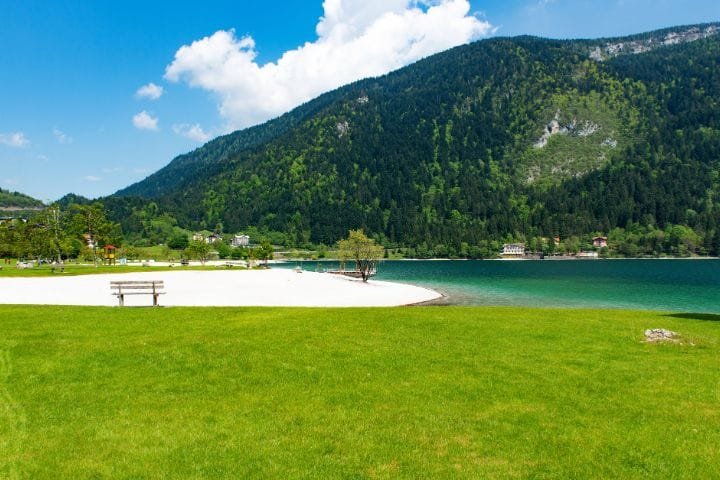
ZTL Zone Violations (My Friends’ Most Expensive Italian Mistake):
Understanding ZTL zones:
- Zona Traffico Limitato: Restricted traffic areas in historic city centers
- Camera-monitored entrances automatically photograph license plates and fine violators
- Fines typically €100-200 that arrive months later at your home address
- Even GPS systems sometimes don’t provide adequate warnings
Smart avoidance strategies:
- Research your hotel’s exact location and parking arrangements before driving
- Ask hotel staff specifically about ZTL zones and safe parking areas
- Use park-and-ride facilities outside historic centers
- Seriously consider trains instead of driving to major historic cities
Last year, my German friends accumulated three separate ZTL fines in Florence – €300 total for innocently driving down the wrong streets while following GPS directions.
Train Ticket Validation Errors:
- Regional train tickets must be validated in yellow machines before boarding
- High-speed trains don’t require validation (seat reservations handle this automatically)
- Forgotten validation equals hefty fines even with completely valid tickets
- Train conductors don’t care about tourist confusion or language barriers
Taxi and Transport Scams:
- Always use official taxis with proper meters or posted fixed rates
- Agree on prices beforehand for longer journeys outside city centers
- Avoid unofficial “taxi” offers at airports, train stations, and tourist areas
Booking and Planning Mistakes I See Constantly
Last-Minute Summer Accommodation Disasters: July-August availability disappears completely, and prices increase dramatically. I’ve had visiting friends literally sleeping in airport lounges because they assumed they could “figure it out” upon arrival.
Better advance planning strategy:
- Book accommodations 3-6 months ahead for the peak summer season
- Consider shoulder seasons (May-June, September-October) for better availability
- Always have backup plans if first-choice locations become fully booked
Skipping Essential Advance Reservations: These popular attractions sell out weeks or months ahead:
- Vatican Museums (especially Sistine Chapel access)
- Uffizi Gallery in Florence during any busy season
- Last Supper viewing in Milan (extremely limited daily slots)
- Popular restaurant reservations in major tourist cities
I book these essential reservations for visiting friends immediately when they confirm travel dates – it’s genuinely that important for smooth experiences.
Overambitious Itinerary Planning: Attempting to see Rome, Florence, Venice, Amalfi Coast, and Tuscany in one week means spending more time traveling than actually experiencing destinations. Much better to see fewer places thoroughly than many places superficially.
Realistic timing expectations:
- Minimum 3 days per major city for meaningful exploration
- Factor in actual travel time between destinations
- Include rest days – Italy can be genuinely overwhelming
- Leave buffer time for spontaneous discoveries and relaxation
Ignoring Traditional Siesta Hours: Many shops, restaurants, and attractions close 1-4 PM, especially in smaller towns and throughout southern regions. Plan accordingly, or you’ll spend hot afternoon hours wandering completely empty streets.
Tourist Traps in Major Cities (Local’s Perspective)
Restaurant Red Flags:
- Multilingual menus with tourist photos usually indicate mediocre food at inflated prices
- Restaurants immediately adjacent to major attractions are often overpriced and underwhelming
- Places aggressively trying to pull you in from the street generally aren’t where locals eat
Better dining strategy:
- Walk 2-3 blocks away from major tourist sights
- Look for restaurants full of locals rather than obvious tourists
- Ask locals for genuine recommendations rather than relying on tourist guides
Venice Gondola Scams:
- Official gondola rides have fixed rates (approximately €80 for 30 minutes)
- Negotiate additional time or special routes beforehand to avoid surprise charges
- Avoid “special deals” that mysteriously end up costing significantly more
- Consider shared gondola rides to reduce per-person costs
Rome Photo Op Payment Demands: Those costumed “gladiators” and “centurions” near the Colosseum will aggressively demand payment after taking photos with you. Either politely decline all interaction or agree on specific prices before any photo opportunities.
Florence Leather Market Realities:
- San Lorenzo market definitely expects haggling for any purchases
- Don’t expect genuine high-quality leather at unrealistically low prices
- Quality authentic goods cost appropriate amounts – extreme bargains are usually fake
- Check stitching, materials, and construction carefully before buying
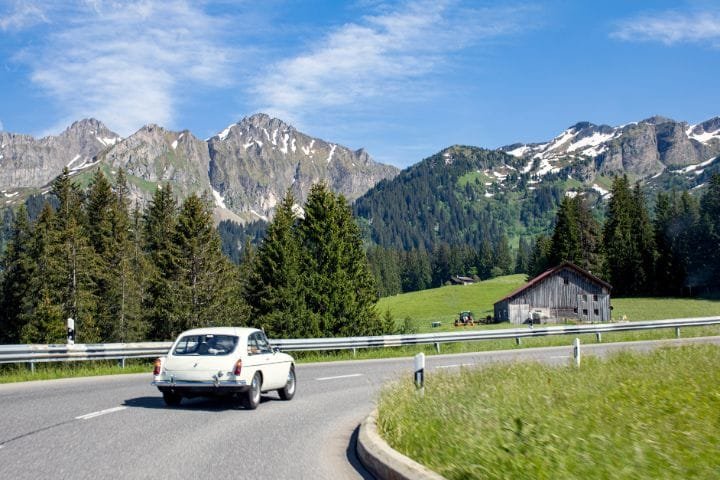
Seasonal Planning Mistakes
Summer Heat Underestimation:
- Italian summer temperatures are genuinely serious – Rome regularly hits 40°C/104°F
- Popular attractions become unbearably crowded during peak hours
- Air conditioning isn’t universal in older historic buildings
- Many locals actually leave major cities during August heat
Winter Expectations vs Reality:
- Northern Italy winters are genuinely cold, with frequent fog
- Coastal attractions have significantly limited winter hours or close completely
- Mountain roads may be closed for weather and safety concerns
- Pack proper winter clothing for northern regions and mountain areas
From my personal experience living here through every season and watching thousands of visitors navigate our country, the tourists who have the most authentic and enjoyable experiences are those who embrace our cultural pace, respect our long-standing customs, and understand that Italy genuinely rewards patience, cultural curiosity, and respectful behavior over rushing through an ambitious checklist.
Sustainable and Responsible Travel in Italy
As someone who’s watched our beautiful country face increasing pressure from mass tourism, especially in fragile places like Venice, Cinque Terre, and the Amalfi Coast, I’m genuinely passionate about helping visitors enjoy Italy responsibly while supporting the local communities I’ve grown up with.
Sustainable Transportation That Actually Works
Train Travel Over Flying: Italy’s excellent rail network makes trains the most sustainable option for intercity travel, and as someone who commutes regularly by train, I can tell you they’re often faster than flying when you factor in airport security and travel time to city centers.
Environmental benefits of rail travel:
- High-speed trains produce 90% less CO2 than equivalent domestic flights
- No airport transportation emissions or time waste
- Significantly reduced noise pollution compared to air travel
- Much more efficient energy use per passenger kilometer
Public Transport in Cities: Italian cities have excellent public transport systems that locals genuinely use daily:
- Rome: Comprehensive metro, bus, and tram network covering the entire metropolitan area
- Milan: Integrated metro/bus/tram system I use daily for everything
- Florence: Excellent bus network plus a completely walkable historic center
- Venice: Vaporetti water buses are literally the only public transport option
Local community benefits:
- Reduces traffic congestion that affects residents’ daily lives
- Supports local transport infrastructure and employment
- Gets you closer to authentic local lifestyle experiences
- Often significantly faster than taxis during busy periods
E-bikes and Cycling Infrastructure: Many Italian regions now offer excellent e-bike infrastructure and rental programs:
- Tuscany: Rolling hills become totally manageable with electric assistance
- Dolomites: Mountain bike trails with convenient e-bike rental locations
- Po Valley: Flat cycling routes perfect for leisurely countryside exploration
- Coastal areas: Scenic routes along Mediterranean coastlines
I’ve done e-bike tours through Chianti region with visiting friends – you cover significantly more ground than walking but still experience the countryside intimately and sustainably.
Eco-Friendly Accommodations in Italy(Local Insider Perspective)
Agriturismos with Genuine Sustainable Practices: These traditional farm stays represent authentic Italian rural life while supporting genuinely sustainable agriculture:
- Organic farming practices producing food served directly to guests
- Solar panels and renewable energy increasingly common throughout rural areas
- Traditional building restoration preserving important cultural heritage
- Direct local employment supporting rural communities and traditional skills
Agriturismo ( Farm Stays ) recommendations:
Green-Certified Hotels and Accommodations: Many Italian hotels now focus seriously on sustainability initiatives:
- Energy-efficient systems in both historic renovations and modern properties
- Local ingredient sourcing for restaurants and amenity production
- Comprehensive waste reduction programs including water conservation
- Traditional renovation methods preserving historic buildings sustainably
Family-Run Accommodations: Staying with local families or in small guesthouses provides multiple benefits:
- Direct economic support flowing to local community members
- Authentic cultural experiences impossible to get from international chains
- Lower environmental impact than large resort complexes
- Personal recommendations for sustainable local experiences and hidden gems
Supporting Local Communities (Authentic Insider Perspective)
Eating at Genuine Family-Run Restaurants: Skip international chains and tourist-focused restaurants for authentic trattorias and family osterias:
- Traditional family recipes passed down through multiple generations
- Local ingredient sourcing supporting regional farmers and producers
- Seasonal menu changes reflecting what’s actually grown locally
- Cultural preservation of regional cooking traditions and techniques
The most memorable meals I’ve experienced in Italy were at tiny family places where nonna still makes pasta by hand using recipes from her own grandmother – these experiences support cultural continuity.
Shopping at Authentic Local Markets: Every Italian city has traditional markets where local residents shop daily for fresh ingredients:
Benefits of market shopping:
- Direct support for local farmers and small food producers
- Seasonal, locally-grown products with minimal transportation impact
- Significantly reduced packaging compared to supermarket shopping
- Cultural immersion in authentic daily Italian life
Best markets for genuine local experiences:
- Bologna: Mercato delle Erbe (where locals and university students shop daily)
- Florence: Sant’Ambrogio market (much less touristy than central Mercato Centrale)
- Rome: Testaccio market (genuine neighborhood institution)
- Palermo: Ballarò market (incredible authentic Sicilian energy and culture)
Avoiding Overtourism Hotspots in Italy
Explore Lesser-Known Destinations with Similar Beauty: Instead of contributing to overcrowding in Venice and Cinque Terre, discover beautiful alternatives that offer similar experiences:
Instead of overcrowded Venice, try:
- Padova: Incredible architecture, vibrant university town energy, authentic Veneto culture
- Mantova: UNESCO World Heritage site with stunning Renaissance palaces
- Chioggia: “Little Venice” with genuine fishing village atmosphere
Instead of packed Cinque Terre, explore:
- Golfo dei Poeti: Equally stunning coastal towns in Liguria region
- Cilento Coast: Pristine beaches and medieval villages with authentic atmosphere
- Puglia coastline: Crystal-clear waters and authentic southern Italian culture
I took visiting friends to Mantova instead of Venice last summer – they were absolutely amazed by the beauty and authentic atmosphere without tourist crowds and inflated prices.
Travel During Shoulder Seasons: May, June, September, and October provide excellent weather while significantly reducing pressure on popular destinations:
- Better prices for accommodation and local services
- More authentic interactions with locals who aren’t overwhelmed by tourist crowds
- Easier access to restaurants and attractions without advance booking stress
- Pleasant weather conditions without summer heat and humidity
Leave-No-Trace Principles for Natural Areas
Mountain and Trail Etiquette: Italian mountain environments are particularly fragile and require respectful behavior:
- Always stay on marked trails to prevent erosion and ecosystem damage
- Pack out absolutely all trash, including organic waste and food scraps
- Respect wildlife viewing distances and avoid disturbing natural behaviors
- Follow seasonal restrictions during animal breeding and nesting seasons
Coastal and Beach Conservation:
- Use only reef-safe sunscreen to protect marine ecosystems from chemical damage
- Avoid all single-use plastics, especially water bottles, near coastlines
- Respect marine protected areas and local fishing restrictions
- Never remove shells, rocks, or sand as souvenirs from beaches
Water Conservation Awareness: Italy faces genuine water shortages during hot summer months, especially in southern regions:
- Take shorter showers and reuse towels when possible
- Don’t waste tap water (it’s excellent quality throughout the country)
- Use refillable water bottles at abundant public fountains
- Be particularly mindful during drought periods in July-August
Cultural Sensitivity and Authentic Respect
Learn Basic Italian Phrases: Even simple greeting attempts show genuine respect for our culture and usually result in much warmer interactions:
Essential respectful phrases:
- “Buongiorno” (good morning) – use until 1 PM
- “Buonasera” (good evening) – appropriate after 1 PM
- “Grazie mille” (thank you very much) – always deeply appreciated
- “Scusi” (excuse me) – for getting attention or apologizing
- “Parla inglese?” (do you speak English?) – polite before assuming
Personal observation: Italians consistently respond more warmly and helpfully to visitors who make genuine effort with basic Italian phrases, even if pronunciation isn’t perfect.
Respect Religious and Cultural Sites:
- Dress appropriately for churches and religious sites throughout the country
- Speak quietly in sacred spaces and during religious services
- Follow photography restrictions especially in museums and churches
- Understand these are active places of worship, not just tourist attractions
Support Traditional Crafts and Artisans: Buy authentic local products directly from artisan workshops rather than mass-produced tourist souvenirs:
- Venetian glass directly from family workshops on Murano island
- Florentine leather goods made by traditional craftspeople using historic techniques
- Sicilian ceramics from multi-generation family workshops
- Tuscan textiles produced using traditional methods and local materials
From my perspective living here and watching tourism’s impact on local communities, the visitors who leave the most positive impression are those who show genuine curiosity about our culture, respect our traditional pace of life, and understand that sustainable travel isn’t just about environmental protection – it’s about preserving the authentic character and cultural traditions that make Italy truly special in the first place.
Italy Travel Tools and Resources
As someone who uses these digital tools daily and has helped countless friends navigate Italy using technology, here are the essential apps and websites that actually make Italian travel smoother and more enjoyable.
Essential Travel Apps I Use Daily
Trenitalia: This is absolutely essential for Italian train travel, and as someone who commutes regularly between cities, I can tell you this official app is genuinely reliable and user-friendly:
- Complete train schedules with real-time updates and delay notifications
- Direct ticket booking with mobile tickets (no need to print)
- Works offline once tickets are downloaded to your phone
- Shows platform changes and departure updates instantly
Moovit: Hands down the best app for local public transport in Italian cities, and I’ve tested them all:
- Real-time bus, metro, and tram information for all major cities
- Route planning with multiple transport options and timing
- Works seamlessly in Rome, Milan, Florence, Naples, and other major destinations
- Offline functionality for downloaded city data
Google Translate: The camera translation feature is absolutely amazing for Italian travel:
- Instantly translates menus, signs, and documents using phone camera
- Download Italian language pack for completely offline functionality
- Voice translation is helpful for basic conversations with locals
- Handwriting recognition is useful for addresses and complex words
I regularly use this with international friends visiting Italy, and watching their faces light up when they can suddenly read Italian menus is genuinely delightful.
TheFork (La Forchetta in Italian): Restaurant reservation app that Italians actually use constantly:
- Shows real-time availability at quality restaurants throughout Italy
- User reviews and ratings from local Italian diners
- Often provides exclusive discounts for app bookings
- Essential for popular restaurants in major tourist cities
Maps.me: Perfect offline mapping solution for areas with limited data coverage:
- Download complete Italian regions before traveling for offline navigation
- Works without any internet connection in remote areas
- Detailed walking and driving directions with points of interest
- Essential for rural areas and mountain regions
Helpful Planning Websites
ItaliaRail: Excellent English-language alternative to Trenitalia’s sometimes confusing website:
- Clear explanations of Italian train system for first-time visitors
- English customer service for complex itineraries and problems
- Detailed route information with timing and connections
- Particularly helpful for understanding regional vs high-speed train differences
ViaMichelin: Essential for anyone planning to drive in Italy:
- Comprehensive route planning with detailed driving directions
- Includes accurate toll costs and fuel consumption estimates
- Real-time traffic information and alternative route suggestions
- Particularly valuable for calculating true driving costs
Booking Platform Recommendations
Skip-the-Line Attraction Tickets:
- Viator: Extensive selection of tours and experiences throughout Italy
- Civitatis: Guided tours, activities, excursions, and travel experiences in destinations around the world
- Official museum websites: Always check these first for best prices and authentic tickets
Accommodation Booking Strategies:
- Hotels.com: Widest selection with excellent filtering options for Italian properties
- Airbnb: Outstanding for longer stays and authentic neighborhood experiences
- Agriturismo.it: Unique farm stay experiences unavailable elsewhere
- Direct hotel websites: Sometimes provide better rates than third-party booking platforms
Transportation and Navigation Tools
Driving Apps for Italian Road Trips:
- Google Maps: Excellent navigation with accurate traffic information
- Waze: Superior real-time traffic updates and speed camera warnings
Public Transport Solutions:
- Citymapper: Works excellently in Rome and Milan with real-time updates
- ATM Milano: Official Milan transport app with comprehensive route planning
- ATAC Roma: Official Rome transport app for buses, metro, and trams
- Moovit: Universal solution working in all major Italian cities
Communication and Language Resources
Translation and Learning Apps:
- Google Translate: Most comprehensive with excellent offline functionality
- iTranslate: Good voice translation features for conversations
- Duolingo: Basic Italian learning before and during your trip
- Babbel: More structured Italian language learning with cultural context
Communication Apps:
- WhatsApp: Universally used in Italy for communication with locals
- Viber: Alternative messaging app popular with some Italian regions
Food and Dining Applications
Restaurant Discovery and Booking:
- TheFork: Primary restaurant reservation platform with local reviews
- TripAdvisor: Restaurant reviews and rankings (though take tourist-focused reviews skeptically)
- Yelp: Less popular in Italy but still useful for basic information
- Zomato: Food delivery service in major cities when you want to stay in
Authentic Food Discovery:
- Slow Food: Guide to authentic local restaurants supporting traditional cuisine
- Gambero Rosso: Prestigious Italian restaurant and wine guide
Money and Payment Solutions
Financial Apps for Italian Travel:
- PayPal: Widely accepted for online purchases and some restaurants
- Revolut: Excellent exchange rates and travel-friendly banking features
- Wise: Outstanding for currency exchange with transparent fees
- Local banking apps: If you have European bank accounts or international banking
Weather and Safety Applications
Weather Forecasting:
- Weather.com: Reliable forecasts for trip planning
- 3B Meteo: Popular Italian weather app with local accuracy
- Windy: Detailed weather maps and forecasts, excellent for outdoor activities
Safety and Emergency Resources:
- Where Are U: Italian emergency location sharing app
- SOS Emergency: Location sharing and emergency contact features
- TravelSafe: Country-specific safety information and emergency contacts
Local Insider Tips for App Usage
Data and Connectivity:
- Download offline maps and translation packs before traveling to rural areas
- Many Italian cafes and restaurants offer free WiFi for customers
- Public WiFi is available in most major tourist areas and transportation hubs
- Consider European SIM card or international data plan for extended stays
Cultural App Etiquette:
- Italians appreciate when visitors attempt to use Italian language apps
- Restaurant reservation apps are genuinely expected for popular places
- Public transport apps are essential – locals assume you’re using them
From decades of experience using technology to navigate Italian travel and helping international friends use these tools effectively, the key is choosing reliable apps that work offline and understanding that technology enhances rather than replaces authentic cultural interactions with locals who are usually happy to help when approached respectfully.
FAQs About Traveling to Italy
Based on questions I get constantly from visiting friends, family, and colleagues over the years, here are the most important things international travelers need to know about visiting our beautiful country.
What documents do I need to travel to Italy
US citizens need a passport that remains valid for at least 3 months beyond your departure date. Starting in 2025, you’ll also need ETIAS authorization (Europe’s new online system, similar to America’s ESTA) obtained before travel.
No visa required for tourist stays under 90 days. Travel insurance isn’t legally required but absolutely recommended from personal experience helping friends navigate emergencies.
Is Italy safe for solo travelers?
Italy is genuinely very safe for solo travelers, including women traveling alone. I have many female friends who’ve traveled extensively throughout our country without any serious issues.
Use normal urban precautions in major cities, avoid completely deserted areas late at night, and trust your instincts. Tourist areas are well-patrolled by police, and Italians are generally helpful and protective toward visitors needing assistance.
Do I need to speak Italian to travel here?
Basic Italian phrases are deeply appreciated and often result in much warmer interactions; however, English is widely spoken in tourist areas, hotels, and restaurants throughout major cities. Younger Italians often speak excellent English from their school education.
Google Translate bridges communication gaps effectively in smaller towns. Making genuine effort with basic greetings and politeness goes incredibly far with locals.
How many days should I spend in Italy for my first visit?
Minimum one week for first-time visitors to experience Rome, Florence, and Venice basics without feeling completely rushed. Ten days allows more relaxed pacing plus meaningful day trips.
Two weeks lets you add entire regions like Tuscany, Amalfi Coast, or northern Italian lakes. Three weeks provides comprehensive coverage including southern regions like Sicily, Puglia, or Sardinia for truly diverse experiences.
Should I rent a car or use trains to get around Italy?
Trains work absolutely best for city-to-city travel between major destinations – they’re faster, more convenient, and eliminate parking stress completely. Rent cars specifically for rural exploration like Tuscany wine country, visiting multiple small hill towns, or regions poorly served by public transport like parts of Sicily and Sardinia. Many smart travelers combine both methods – trains between major cities, strategic car rentals for countryside regions.
Personal recommendation: This combined approach is exactly what I suggest to visiting friends, and it works perfectly every time.
What’s the best time to visit Italy if I want to avoid crowds?
May, early June, September, and October offer excellent weather conditions with totally manageable crowd levels. Absolutely avoid July-August for popular destinations like Venice, Amalfi Coast, and Tuscany unless you enjoy feeling like sardines.
Winter provides incredibly authentic experiences with minimal tourists but significantly limited hours for coastal attractions. Easter week is extremely crowded throughout the entire country.
How much should I realistically budget per day for Italy?
Budget travel: €40-60 daily (hostels, local food, public transport, free attractions). Mid-range comfort: €100-150 daily (nice hotels, good restaurants, some tours and experiences).
Luxury experiences: €200+ daily (high-end accommodations, fine dining, private guides and exclusive access). Costs vary dramatically by region and season – Rome and Venice are most expensive, smaller towns and southern regions much more affordable.
What’s the real deal with tipping in Italy?
Service charges (coperto) are typically included in restaurant bills as standard practice, not tourist scams. Leave small change for genuinely good service experiences, but 15-20% American-style tips aren’t expected and can actually make servers uncomfortable.
Are Italian trains actually reliable and punctual?
High-speed trains (Frecciarossa, Italo) are extremely reliable and punctual – I depend on them for business travel constantly. Regional trains occasionally have minor delays but generally maintain schedules well.
Always book seat reservations for high-speed trains, especially during busy seasons. Strike days (sciopero) occasionally affect service but with advance public notice and alternative arrangements.
Can I safely drink tap water throughout Italy?
Absolutely yes! Italian tap water maintains excellent quality standards throughout the entire country. Public fountains (nasoni in Rome, for example) provide fresh, cold water perfect for refilling bottles constantly. Drinking public fountain water saves significant money and reduces plastic waste.
What should I know about Italian meal times and restaurant culture?
Lunch typically starts around 1 PM, dinner rarely begins before 8 PM throughout most regions. Many restaurants close completely between 3-7 PM for riposo (rest period).
Is it worth visiting Italy during winter months?
Winter Italy offers incredibly authentic experiences with minimal tourist crowds and significantly lower prices. Northern cities can be cold and foggy, but southern regions remain pleasant for sightseeing when northern Europe is freezing.
Christmas markets in Alto Adige region are magical. Many coastal attractions have reduced hours or close completely. Pack appropriate winter clothing for northern regions and mountain areas.
How do I avoid looking like an obvious tourist?
Dress appropriately – Italians notice style and appreciate effort. Learn basic Italian greetings and politeness. Eat where locals eat rather than tourist-focused restaurants.
Respect meal timing and cultural customs. Don’t wear athletic clothing for dining or sightseeing. Carry yourself confidently and respectfully. Show genuine interest in local culture rather than just checking off tourist attractions.
Final Words
From my experience living here and interacting with thousands of international visitors over the years, Italy rewards travelers who approach our country with cultural curiosity, respect for local customs, and genuine appreciation for authentic experiences over superficial tourist activities. The visitors who leave with the most meaningful memories are those who embrace our pace of life and understand that the best Italian experiences often happen spontaneously through authentic human connections.
Italy isn’t just a destination to visit – it’s a cultural immersion that changes how you see food, art, history, and the fundamental importance of taking time to truly savor life’s beautiful moments.
The secret to an unforgettable Italian journey isn’t frantically checking famous attractions off your list – it’s understanding that our country reveals itself in layers through genuine human connections.
The Roman waiter who recommends his grandmother’s secret recipe, the Florentine artisan who explains centuries-old leather-working techniques passed down through generations, the Venetian gondolier who shares family stories while navigating quiet backwater canals – these moments of authentic cultural exchange transform a good vacation into something genuinely life-changing.
Plan thoughtfully using the local insights I’ve shared throughout this guide, pack appropriately for our diverse climates and cultural expectations, and prepare yourself for a country that will exceed every expectation while gently challenging your assumptions about what travel can truly offer. Italy rewards patience, cultural curiosity, and genuine respect for local traditions with experiences that remain vivid in memory long after you return home.
Benvenuti in Italia! (Welcome to Italy!) We can’t wait to share our incredible country with you.
Buon viaggio! (Have a wonderful journey!)
Tailor your trip based on your time, interests, and pace.
Get our FREE Italy
Travel Guide
E-Book
This printable guide is your ultimate companion for exploring Italy, with insider tips, detailed itineraries, transportation advice, must-see attractions, and more.

💬 We’d love to hear from you!
Have questions, tips, or personal travel stories to share? Drop them in the comments below — your insights help fellow travelers plan their adventures too.





